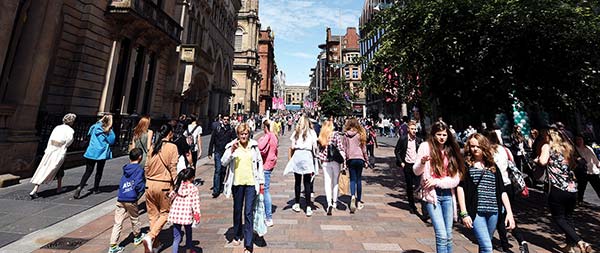
GET TO KNOW GLASGOW: THE DOWNTOWN CORE
Nightlife and Entertainment in Glasgow
Map: Central Glasgow Hotels & Restaurants
Glasgow (GLAS-goh)—astride the River Clyde—is a surprising city. In its heyday, Glasgow was one of Europe’s biggest cities and the second-largest in Britain, right behind London. A century ago it had 1.2 million people, twice the size (and with twice the importance) of today. It was an industrial powerhouse producing 25 percent of the world’s oceangoing ships. But in the mid-20th century, tough times hit Glasgow, giving it a rough edge and a run-down image.
At the city’s low point during the Margaret Thatcher years (1980s), its leaders embarked on a systematic rejuvenation designed to again make Glasgow appealing to businesses, tourists...and locals. Today the city feels revitalized and goes out of its way to offer a warm welcome. Glaswegians (rhymes with “Norwegians”) are some of the chattiest people in Scotland—and have the most entertaining (and impenetrable) accent.
Many travelers give Glasgow a miss, but that’s a shame: I consider it Scotland’s most underrated destination. Glasgow is a workaday Scottish city as well as a cosmopolitan destination, with an unpretentious friendliness, an energetic dining and nightlife scene, top-notch museums (most of them free), and a unique flair for art and design. It’s also a pilgrimage site for architecture buffs, thanks to a cityscape packed with Victorian facades, early 20th-century touches, and bold and glassy new construction. Most beloved are the works by hometown boy Charles Rennie Mackintosh, the visionary—and now very trendy—architect who left his mark all over Glasgow at the turn of the 20th century.
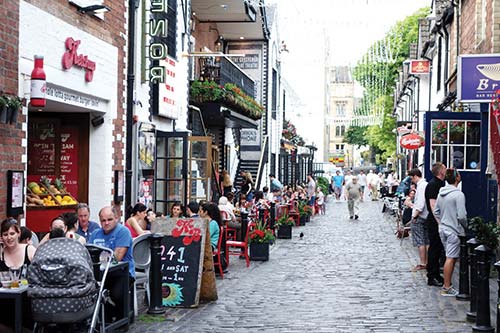
Many more tourists visit Edinburgh, a short train trip away. But for a more complete look at urban Scotland, be sure to stop off in Glasgow. Edinburgh may have the royal aura, but Glasgow has down-to-earth appeal. In Glasgow, there’s no upper-crust history, and no one puts on airs. In Edinburgh, people identify with the quality of the school they attended; in Glasgow, it’s their soccer team allegiance. One Glaswegian told me, “The people of Glasgow have a better time at a funeral than the people of Edinburgh have at a wedding.” Here, friendly locals do their best to introduce you to the fun-loving, laid-back Glaswegian way of life.
While many visitors blitz Glasgow as a day trip from Edinburgh or Stirling (and a single day in Glasgow is certainly more exciting than a fourth day in Edinburgh), the city can easily fill two days of sightseeing.
On a quick visit, follow my “Get to Know Glasgow” self-guided walk of the city center, tying together the most important sights in the city’s core. If your time is short, the interiors most worth considering are the Tenement House and the Kelvingrove Museum.
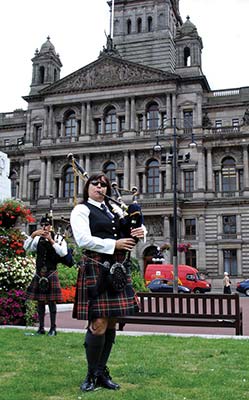
With additional time, your options open up. Follow my West End Walk to get a taste of Glasgow’s appealing residential zone, which has some of the city’s best restaurants as well as a number of worthwhile sights. Fans of Art Nouveau and Charles Rennie Mackintosh can lace together a busy day’s worth of sightseeing (the TI has a brochure laying it out). At a minimum, those interested in Mackintosh should visit the Mackintosh House at the Hunterian Gallery (in the West End) and the Mackintosh exhibit at the Kelvingrove Museum.
Regardless of how long you’re staying, consider the two-hour hop-on, hop-off bus tour, which is convenient for getting the bigger picture and reaching three important sights away from the center (the Cathedral Precinct, the Riverside Museum, and the Kelvingrove Museum).
Day Trip from Edinburgh: For a full day, catch the 9:30 train to Glasgow (morning trains every 10 minutes; discount for same-day round-trip if leaving after 9:15 or on weekend); it arrives at Queen Street Train Station before 10:30. To fill your Glasgow hours smartly, I’d do the entire hop-on, hop-off bus tour circuit (two hours), then follow my self-guided walk through downtown (finishing with the Tenement House). Next, check out the Kelvingrove Museum and have dinner nearby (in the Finnieston area). Catch a train that leaves around 21:00 to return to Edinburgh (evening trains depart every 10-20 minutes).
Although it’s often thought of as a “second city,” Glasgow is actually Scotland’s biggest (pop. 600,000, swelling to 1.2 million within Greater Glasgow—that’s one out of every five Scots).
The tourist’s Glasgow has two parts: the businesslike downtown (train stations, commercial zone, and main shopping drag) and the residential West End (B&Bs, restaurants, and nightlife). Both areas have good sights, and both are covered in this chapter by self-guided walks.
Glasgow’s downtown is a tight grid of boxy office buildings and shopping malls, making it feel more like a midsized American city than a big Scottish one—like Cincinnati or Pittsburgh, but with shorter skyscrapers made of Victorian sandstone rather than glass and steel. The walkable city center has two main drags, both lined with shops and crawling with shoppers: Sauchiehall Street (pronounced “Suckyhall,” running west to east) and Buchanan Street (running north to south). These two pedestrian malls—part of a shopping zone nicknamed the Golden Zed—make a big zig and zag through the heart of town (the third street of the Zed, Argyle Street, is busy with traffic and less appealing).
The West End is a posh suburb, with big homes, upscale apartment buildings, and lots of green space. The area has three pockets of interest: near the Hillhead subway stop, with a lively restaurant scene and the Botanic Gardens; the University of Glasgow campus, with its stately buildings and fine museums; and, just downhill through a sprawling park, the area around the Kelvingrove Museum, with a lively nearby strip of trendy bars and restaurants (Finnieston).
The TI is inside the Gallery of Modern Art on Royal Exchange Square, downstairs. They hand out a good, free map and brochures on Glasgow and the rest of Scotland (daily 10:00-17:00, www.visitscotland.com).
By Train: Glasgow, a major Scottish transportation hub, has two main train stations, which are just a few blocks apart in the heart of town: Central Station (with a grand, genteel interior under a vast steel-and-glass Industrial Age roof) and Queen Street Station (more functional, with better connections to Edinburgh—take the exit marked Buchanan Street to reach the main shopping drag). Both stations have pay WCs and baggage storage. If going between the stations to change trains, you can walk five minutes or take the roundabout “RailLink” bus #398 (free with train ticket, otherwise £1.20, 5/hour; also goes to bus station).
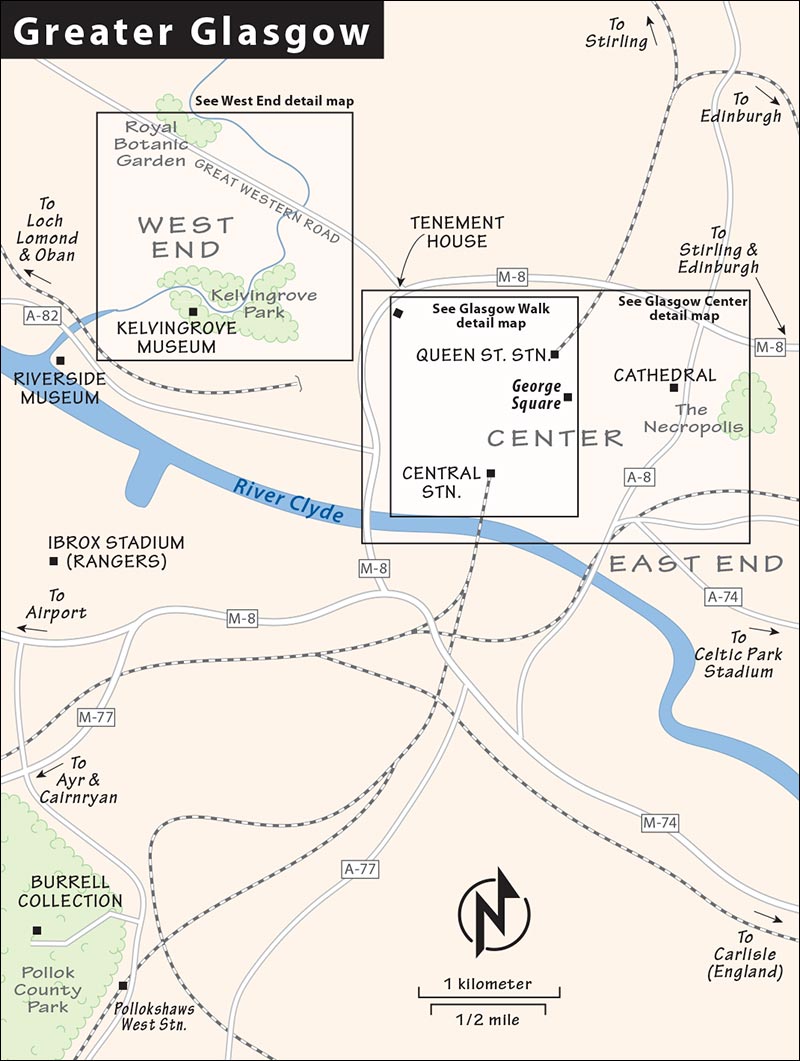
By Bus: Buchanan bus station is at Killermont Street, two blocks up the hill behind Queen Street Station (luggage lockers; travel center open daily 9:00-17:00).
By Car: Glasgow’s downtown streets are steep, mostly one-way, congested with buses and pedestrians, and a horrible place to drive. Parking downtown is a hassle: Metered street parking is expensive (£3/hour) and limited to two hours during the day; garages are even more expensive (figure £25 for 24 hours). Ideally, do Glasgow without a car—for example, tour Edinburgh and Glasgow by public transit, then pick up your rental car on your way out of town. If you are stuck with a car in Glasgow, try to sleep in the West End, where driving and parking are easier (and use public transportation or taxis as necessary).
The M-8 motorway, which slices through downtown Glasgow, is the easiest way in and out of the city. Ask your hotel for directions to and from the M-8, and connect with other highways from there.
By Plane: For information on Glasgow’s two airports, see “Glasgow Connections,” at the end of this chapter.
Safety: The city center, which is packed with ambitious career types during the day, can feel deserted at night. While the area between Argyle Street and the River Clyde has been cleaned up in recent years, parts can still feel sketchy. As in any big city, use common sense and don’t wander down dark, deserted alleys. The Golden Zed shopping drag, the Merchant City area (east of the train stations), and the West End all bustle with crowded restaurants well into the evening and feel well populated in the wee hours.
If you’ve picked up a football (soccer) jersey or scarf as a souvenir, don’t wear it in Glasgow; passions run very high, and most drunken brawls in town are between supporters of Glasgow’s two rival soccer clubs: Celtic in green, and Rangers in blue and red. (For more on the soccer rivalry, see here.)
Sightseeing: Almost every sight in Glasgow is free, but request £3-5 donations (www.glasgowmuseums.com). While these donations are not required, I like to consider what the experience was worth and decide if and how much to donate as I leave. (Voluntary donations are a nice option—but will only work if people actually donate.) Note that most city sights have the same hours: Mon-Thu and Sat 10:00-17:00, Fri and Sun from 11:00, closed Monday.
Sunday Travel: Bus and train schedules are dramatically reduced on Sundays and in the off-season. (If you want to get to the Highlands by bus on a Sunday in winter, forget it.)
Laundry: Majestic Launderette will pick up and drop off at your B&B or hotel (call to arrange); they also have a launderette near the Kelvingrove Museum in the West End (self-serve or full-serve, Mon-Fri 8:00-18:00, Sat until 16:00, Sun 10:00-16:00, 1110 Argyle Street, tel. 0141/334-3433).
By City Bus: Most city-center routes are operated by First Bus Company (£2.20/ride, £4.50 for all-day ticket on First buses, buy tickets from driver, exact change required). Buses run every few minutes down Glasgow’s main thoroughfares (such as Sauchiehall Street) to the downtown core (train stations). You can also get around the city via hop-on, hop-off bus (see “Tours in Glasgow,” next).
By Taxi: Taxis are affordable, plentiful, and often come with nice, chatty cabbies (if your driver has an impenetrable Glaswegian accent, just smile and nod). Most taxi rides within the downtown area cost about £6; to the West End is about £8.
By Uber: Uber works particularly well in Glasgow and lets you make quick connections for about £5.
By Subway: Glasgow’s cute little single-line subway system, nicknamed The Clockwork Orange, makes a six-mile circle that has 15 stops. While simple today, when it opened in 1896 it was a wonder (it’s the world’s third-oldest subway system, after those in London and Budapest). Though the subway is useless for connecting city-center sightseeing (Buchanan Street and St. Enoch are the only downtown stops), it’s ideal for reaching sights farther out, including the Kelvingrove Museum (Kelvinhall stop) and West End restaurant/nightlife neighborhood (Hillhead stop). Ticket options are: £1.65 single trip, £4 for all-day ticket, or frequent riders can get a £3 Bramble card, which is reloadable and reduces your single-ride cost to £1.45 (subway runs Mon-Sat 6:30-23:15, Sun 10:00-18:00, www.spt.co.uk/subway).
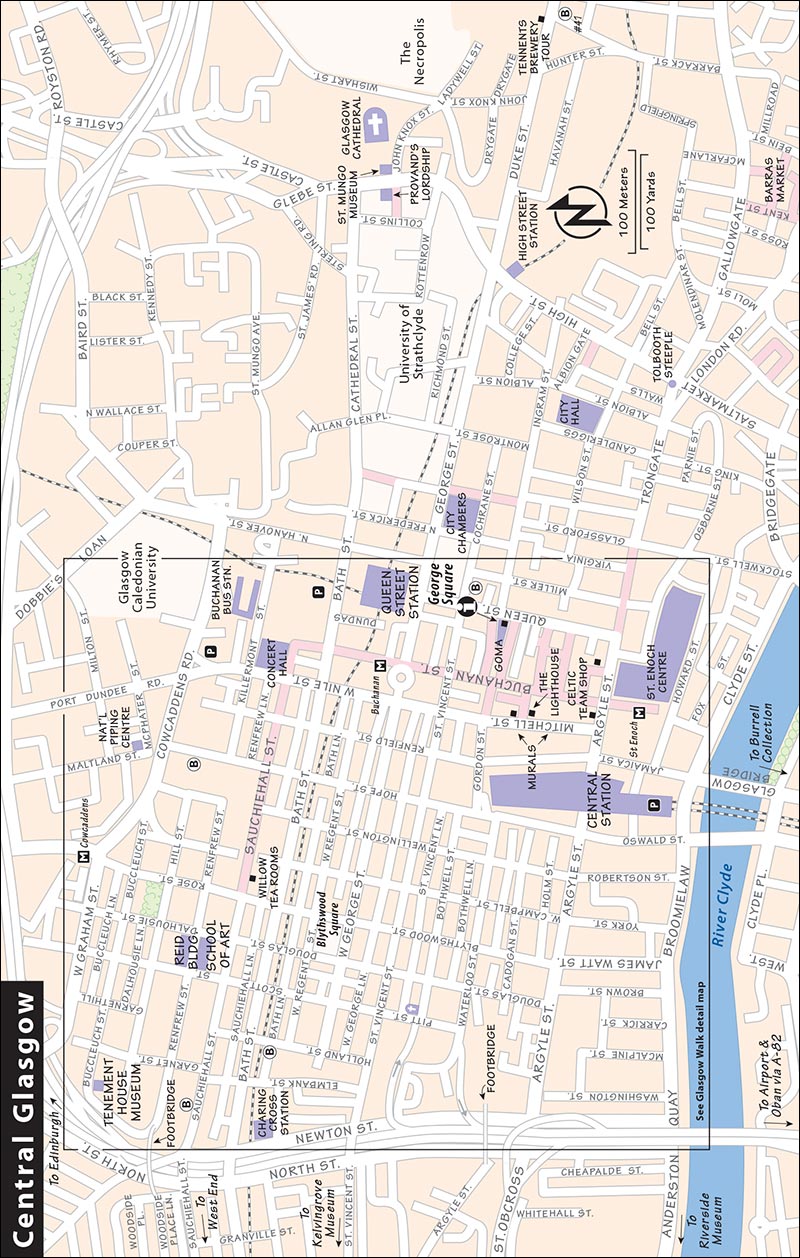
CitySightseeing connects Glasgow’s far-flung historic sights in a two-hour loop and lets you hop on and off as you like for two days. Buses are frequent (every 10-20 minutes, 9:30-18:20, service ends earlier in off-season) and alternate between live guides and recorded narration (both are equally good). The route covers the city very well, and the guide does a fine job of describing activities at each stop. While the first stop is on George Square, you can hop on and pay the driver anywhere along the route (£15, tel. 0141/204-0444, www.citysightseeingglasgow.co.uk).
Walking Tours in Glasgow was started by Jenny and Liv, two recent University of Glasgow graduates who love their city. The city center tour starts in George Square and covers about 3.5 miles in 2.5 hours (daily 10:30 and 14:00; off-season tours by request). They also run a West End tour at 14:30 that requires advance booking (£10, www.walkingtoursin.com, walkingtoursinglasgow@gmail.com).
Trainspotters may enjoy the guided, behind-the-scenes tours of Central Station, including a spooky, abandoned Victorian train platform (book ahead, www.glasgowcentraltours.co.uk).
Those with a specific interest in Mackintosh architecture should consider the 2.25-hour Mackintosh-themed city walking tours given by students of the Glasgow School of Art (£20, 4/week, see here).
Joan Dobbie, a native Glaswegian and registered Scottish Tourist Guide, will give you the insider’s take on Glasgow’s sights (£135/half-day, £200/day, tours on foot or by public transit—no tours by car, tel. 01355/236-749, mobile 07773-555-151, joan.leo@lineone.net).
Ann Stewart is a former high-school geography teacher turned Blue Badge guide who is excited to show you around Glasgow or take you on an excursion outside the city (£150/4 hours, £220/8 hours, mobile 07716-358-997, www.comeseescotland.com, ann@comeseescotland.com).
Most of the same companies that do Highlands side-trips from Edinburgh also operate trips from Glasgow. If you’d like to spend an efficient day away from the city, skim the descriptions and listings on here, and then check each company’s website or browse the brochures at the TI for details.
These two self-guided walks introduce you to Glasgow’s most interesting (and very different) neighborhoods: the downtown zone, and the residential and university sights of the West End.
(See “Downtown Walk” map, here.)
Glasgow isn’t romantic, but it has an earthy charm, its people are a joy to chat with, and architecture buffs love it. The more time you spend here, the more you’ll appreciate the edgy, artsy vibe and the quirky, fun-loving spirit. Be sure to look up—above the chain restaurants and mall stores—and you’ll discover a wealth of imaginative facades, complete with ornate friezes and expressive sculptures. These buildings transport you to the heady days around the turn of the 20th century—when the rest of Britain was enthralled by Victorianism, but Glasgow set its own course, thanks largely to the artistic bravado of Charles Rennie Mackintosh and his Art Nouveau friends (the “Glasgow Four”). This walking tour takes about 1.5 hours (plus sightseeing stops along the way).
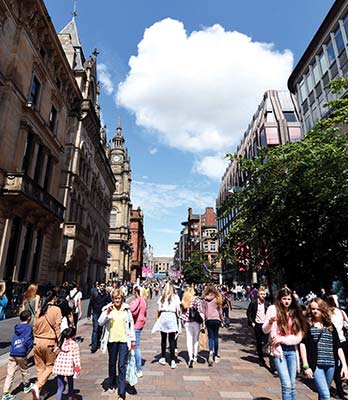
• Start at the St. Enoch subway station, at the base of the pedestrian shopping boulevard, Buchanan Street. (This is a short walk from Central Station, or a longer walk or quick cab ride from Queen Street Station.) Stand at the intersection of Argyle and Buchanan, where the square hits the street (with your back to the glassy subway entry). Take a moment to get oriented.
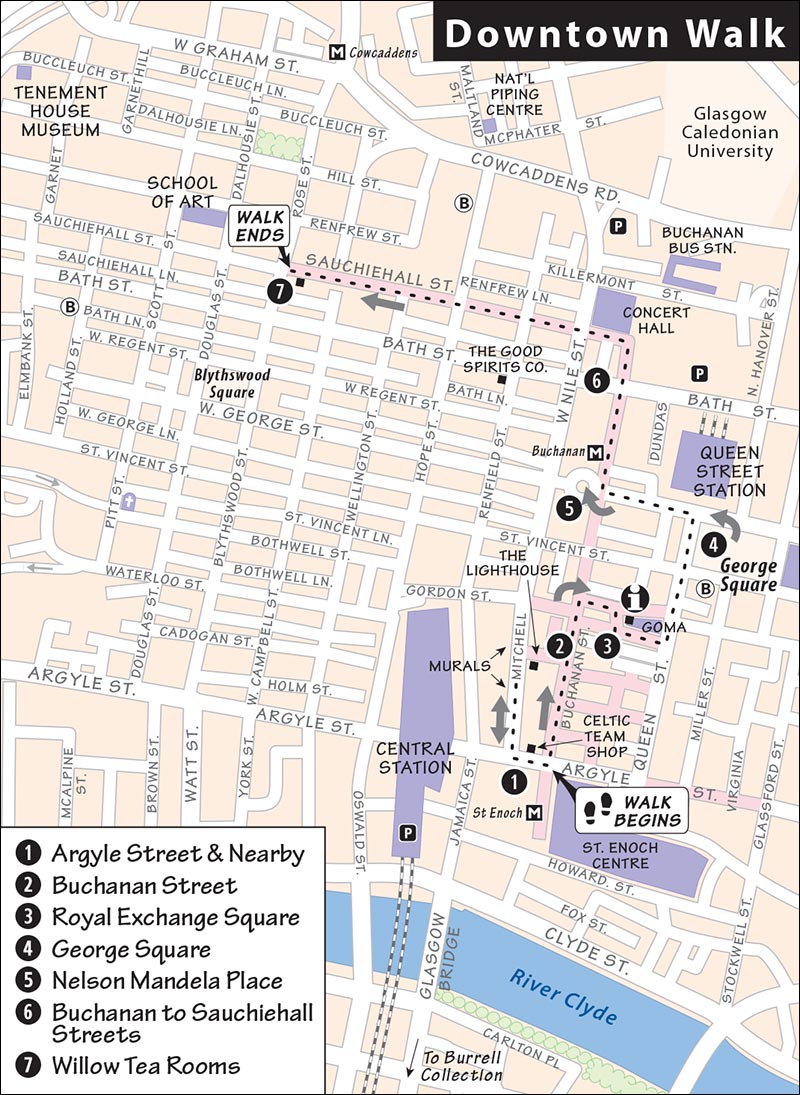
The grand pedestrian boulevard, Buchanan Street, leads uphill to the Royal Concert Hall. This is the start of the “Golden Zed”—the nickname for a Z-shaped pedestrian boulevard made of three streets: Buchanan, Sauchiehall, and Argyle. Always coming up with marketing slogans to goose the shopping metabolism of the city, this district (with the top shops in town) is also called the “Style Mile.”
Look left (a long block away) to where Central Station (with its huge glass facade) makes a bridge over Argyle Street. This bridge was nicknamed “The Highlanders’ Umbrella” from the days when poor Highlanders, who came to Glasgow to find work, would gather here to connect with their community.
Before heading up Buchanan Street, take a quick detour down Argyle to see a couple slices of Glasgow life. About halfway to the Highlanders’ Umbrella on the right, step into the extremely green sports store, the Celtic Shop (at #154).
Green is the color of Glasgow’s dominant (for now) soccer team. It’s hard for outsiders to fathom the intensity of the rivalry between Glasgow’s Celtic and Rangers. Celtic, founded by an Irish Catholic priest to raise money for poor Irish immigrants in the East End, is—naturally—green and favored by Catholics. (For reasons no one can explain, the Celtic team name is pronounced “sell-tic”—like it is in Boston; in all other cases, such as when referring to music, language, or culture, this word is pronounced “kell-tic.”) Rangers, with team colors of the Union Jack (red, white, and blue), are more likely to be supported by Unionist and Protestant families. Wander into the shop (minimizing or hiding any red or blue you might be wearing). Check out the energy in the photos and shots of the stadium filled with 60,000 fans. You’re in a world where red and blue don’t exist. Upstairs, tucked in a back room, is a trophy room with photos of the 1967 team, considered the best in club history.
Now head around the corner from the Celtic Shop and walk a few steps down the alley (Mitchell Street). While it seems a bit seedy, it should be safe...but look out for giant magnifying glasses and taxis held aloft by balloons. City officials have cleverly co-opted street artists by sanctioning huge, fun, and edgy graffiti murals like these. (You’ll see even more if you side-trip down alleys along the Style Mile.) The girl with the magnifying glass is painted by graffiti artist Smug (see the girl’s necklace). In the taxi painting, the driver is actually the artist and the license plate alludes to his tag name: Rogue-One. (By the way, there are no actual bricks on that wall.) Glasgow produces a free booklet, called City Center Mural Trail (also available at www.citycentremuraltrail.co.uk), which explains all this fun art around town.
• Now return to the base of...
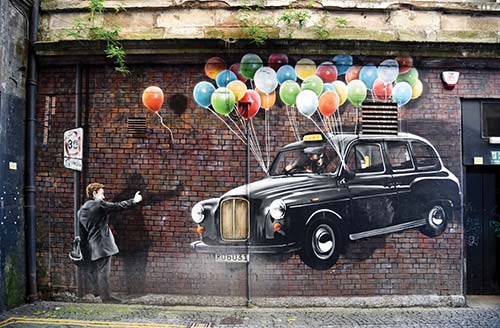
Buchanan Street has a friendly Ramblas-style vibe with an abundance of street musicians. As you stroll uphill, keep an eye out for a few big landmarks: Frasers (#45, on the left) is a vast and venerable department store, considered the “Harrods of Glasgow.” The Argyll Arcade (#30, opposite Frasers), dating from 1827 with a proud red-sandstone facade, is the oldest arcade in town. It’s filled mostly with jewelry and comes with security guards dressed in Victorian-era garb. Princes Square (at #48, just past Argyll Arcade) is a classic old building dressed with a modern steel peacock and foliage. Step inside to see the delightfully modernized Art Nouveau atrium.
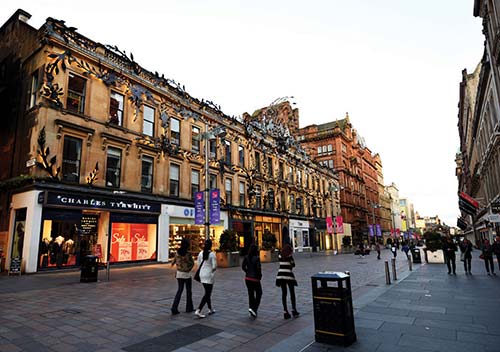
At #97 (50 yards up, on the left) is one of two Mackintosh-designed Willow Tea Rooms (the other location, described later in this walk, is the original). This central location is designed to capitalize on the trendiness of Mackintosh.
• Just past the tearooms, turn down the alley on the right, called Exchange Place. You’ll pass the recommended Rogano restaurant on your right before emerging onto...
The centerpiece of this square—which marks the entrance to the shopping zone called Merchant City—is a stately, Neoclassical, bank-like building. This was once the private mansion of one of the tobacco lords, the super-rich businessmen who reigned here through the 1700s, stomping through the city with gold-tipped canes. During the port’s heyday, these entrepreneurs helped Glasgow become Europe’s sixth-biggest city—number two in the British Empire.
Today the mansion houses the Glasgow Gallery of Modern Art, nicknamed GoMA. Circle around the building to the main entry (at the equestrian statue of the Duke of Wellington, often creatively decorated as Glasgow’s favorite conehead), and step back to take in the full Neoclassical facade. On the pediment, notice the funky, mirrored mosaic celebrating the miracles of St. Mungo—an example of how Glasgow refuses to take itself too seriously. The temporary exhibits inside GoMA are generally forgettable, but the museum does have an unusual charter: It displays only the work of living artists (free, £2 suggested donation, daily 10:00-17:00, TI inside and downstairs).
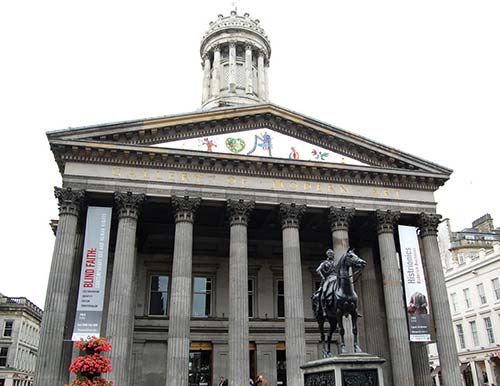
• Facing the fanciful GoMA facade, turn right up Queen Street. Within a block, you’ll reach...
This square, the centerpiece of Glasgow, is filled with statues and lined with notable buildings, such as the Queen Street train station and the Glasgow City Chambers. (It’s the big Neoclassical building standing like a secular church to the east; pop in to see its grand ground floor.) In front of the City Chambers stands a monument to Glaswegians killed fighting in the World Wars. The square is decorated with a Who’s Who of statues depicting great Glaswegians. Find James Watt (the only guy with a chair; he perfected the steam engine that helped power Europe into the Industrial Age), as well as Scotland’s two top literary figures: Robert Burns and Sir Walter Scott (capping the tallest pillar in the center). The twin equestrian statues are of Prince Albert and a skinny Queen Victoria—a rare image of her in her more svelte youth.
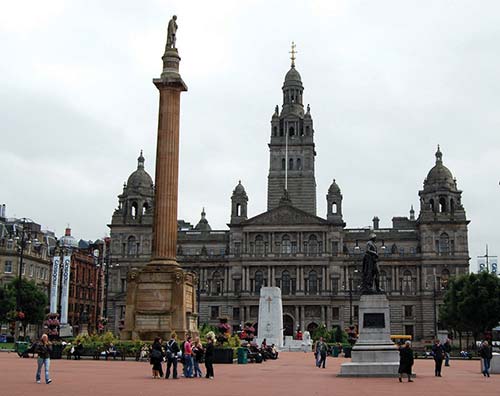
• Just past skinny Vic and Robert Peel, turn left onto West George Street, and cross Buchanan Street to the tall church in the middle of...
This first public space named for Nelson Mandela honors the man who, while still in prison, helped bring down apartheid in South Africa. The square was renamed in the 1980s while apartheid was still in place—and when the South African consulate was on it. Subsequently, anyone sending the consulate a letter had to address it with the name of the man who embodied the anti-apartheid spirit: Mandela. (Glasgow, nicknamed Red Clyde Side for its socialist politics and empathy for the working class, has been quick to jump on progressive causes.)
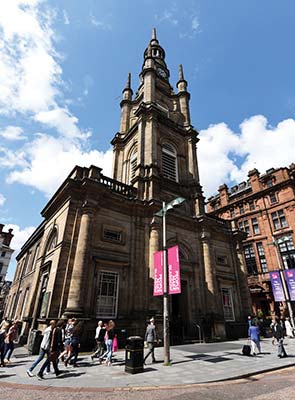
The area around St. George’s Church features some interesting bits of architectural detail. Facing the church’s left side are the three circular friezes of the former Stock Exchange (with a Neo-Gothic facade, built in 1875). These idealized heads represent the industries that made Glasgow prosperous during its prime: building, engineering, and mining.
Around the back of the church, find the Athenaeum, the sandy-colored building at #8 (notice the low-profile label over the door). Now a law office, this was founded in 1847 as a school and city library during Glasgow’s Golden Age. (Charles Dickens gave the building’s inaugural address.) Like Edinburgh, Glasgow was at the forefront of the 18th-century Scottish Enlightenment, a celebration of education and intellectualism. The Scots were known for their extremely practical brand of humanism; all members of society, including the merchant and working classes, were expected to be well educated. Look above the door to find the symbolic statue of a reader sharing books with young children, an embodiment of this ideal.
• Return to the big, pedestrianized Buchanan Street in front of the church. Head uphill.
A short distance uphill is the glass entry to Glasgow’s subway. Soon after, on the right, you’ll pass the Buchanan Galleries, an indoor mall that sprawls through several city blocks (filled with shopping temptations and offering a refuge in rainy weather).
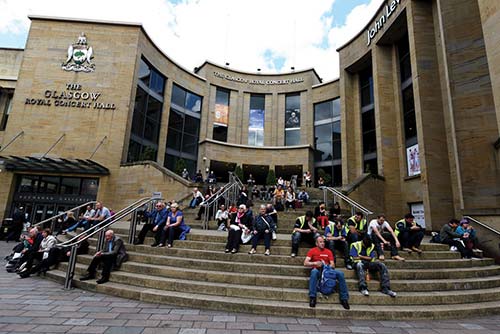
Whisky Side-trip: For a fun education in whisky, take a little detour. At Buchanan Galleries, head left down Bath Street 1.5 blocks to #23, where stairs lead down into The Good Spirits Company. This happy world of whisky is run by two young aficionados (Shane and Matthew) and their booze-geek staff. They welcome you to taste and learn (Mon-Sat 10:00-19:00, Sun 12:00-17:00, tel. 0141/258-8427).
• Returning to Buchanan Street, continue uphill to the top.
At the top of Buchanan Street stands the Glasgow Royal Concert Hall. Its steps are a favorite perch where local office workers munch lunch and enjoy the street scene. The statue is of Donald Dewar, who served as Scotland’s first-ever “First Minister” after the Scottish Parliament reconvened in 1999 (previously they’d been serving in London—as part of the British Parliament—since 1707).
• From here, the Golden Zed zags left, Buchanan Street becomes Sauchiehall Street, and the shopping gets cheaper and less elegant. While there’s little of note to see, it’s still an entertaining stroll. Walk a few blocks, passing “Pound Shops” (the equivalent of “dollar stores”), newspaper hawkers, beggars, buskers, souvenir shops, and a good bookstore. Enjoy the people-watching. Just before the end of the pedestrian zone, on the left side (at #217), are the...
Tearooms were hugely popular during the industrial boom of the late 19th century. As Glasgow grew, more people moved to the suburbs, meaning that office workers couldn’t easily return home for lunch. And during this age of Victorian morals, the temperance movement was trying to discourage the consumption of alcohol. Tearooms were designed to be an appealing alternative to eating in pubs.
These tearooms, opened in 1903, are also an Art Nouveau masterpiece by Charles Rennie Mackintosh. Mackintosh made his living from design commissions, including multiple tearooms for businesswoman Kate Cranston. Mackintosh designed everything here—down to the furniture, lighting, and cutlery. He took his theme for the café from the name of the street it’s on—saugh is Scots for willow.
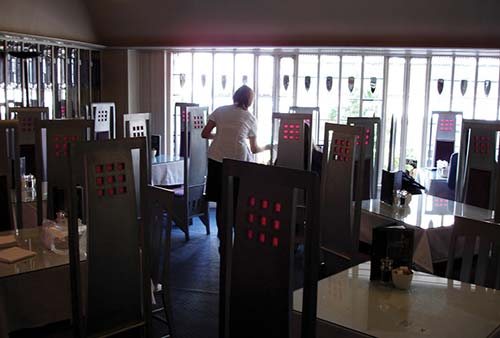
In the design of these tearooms, there was a meeting of the (very modern) minds. In addition to giving office workers an alternative to pubs, Cranston also wanted a place where women could gather while unescorted—in a time when traveling solo could give a woman a less-than-desirable reputation. An ardent women’s rights supporter, Cranston requested that the rooms be bathed in white, the suffragettes’ signature color.
At the Willows, you can have tea or just browse the exhibits showcasing his designs along with Mackintosh-inspired jewelry. The almost-hidden Room de Luxe dining room (upstairs) appears just as it did in Mackintosh’s day, though most features are reproductions, such as the chairs and the doors, which were too fragile to survive (for details, see listing on here).
• Our walk ends here. Within a few minutes’ stroll are three more interesting sights. One of those is the Glasgow School of Art, which was gutted by a 2014 fire. Before the fire, this building, designed by 28-year-old Charles Rennie Mackintosh, attracted architects from far and wide. Now it’s closed for a few years for repairs. Until it reopens, there are better Mackintosh sights for his fans to visit.
Two additional sights (described later) lie within a five-minute stroll (in different directions). The remarkably preserved Tenement House offers a fascinating glimpse into Glasgow lifestyles in the early 1900s. And the National Piping Centre goes beyond the clichés and provides a better appreciation for the history and musicality of Scotland’s favorite instrument.
(See “Glasgow West End” map, here.)
Glasgow’s West End—just a quick subway, bus, or taxi ride from downtown—is the city’s top residential neighborhood. (Since this walk is most worthwhile as a scenic way to connect several important museums, be sure to do this when they’re open.) As in so many British cities, the western part of town—upwind of industrial pollution—was the most desirable. This area has great restaurants and nightlife (see “Eating in Glasgow” and “Nightlife and Entertainment in Glasgow,” later) and fine accommodations (see “Sleeping in Glasgow,” later). This walk begins at the Hillhead subway stop, meanders through dining and residential zones, explores some grand old university buildings (and related museums), and ends with a wander through the park to the Kelvingrove Museum—Glasgow’s top museum (walk route shown on here).
• Start at the Hillhead subway station. Exiting the station, turn right and walk four short blocks up...
Byres Road: A byre is a cowshed. So back when this was farmland outside the big city, cattle were housed along here. Today, Byres Road is a main thoroughfare through a trendy district. A block before the big intersection, notice the Waitrose supermarket on the left. In Britain, this upscale grocery is a sure sign of a posh neighborhood.
Approaching the corner with Great Western Road, you’ll see a church spire on the right. Dating from 1862, this church was converted into a restaurant and music venue called Òran Mòr (Gaelic for “The Great Music”). Step into the entryway to see the colorful murals (by Alasdair Gray, a respected Glaswegian artist and novelist). Consider a drink or meal in their pub (try some whisky—they have over 300 varieties). Also check what’s on while you’re in town, as this is a prime music and theater venue.
• If the weather’s good, cross Great Western Road and head into the...
Glasgow Botanic Gardens: This inviting parkland is Glaswegians’ favorite place to enjoy a break from the bustling city. And, like so many things in Glasgow, it’s free. Locals brag about their many parks, claiming that—despite their industrial reputation—they have more green space per capita than any other city in Europe. And even the city’s name comes from the Gaelic for “the dear green place.”
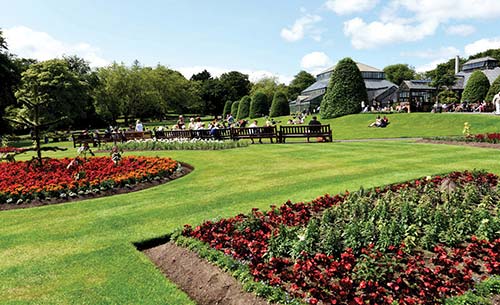
Before going into the park, pause at the red-brick entrance gate. On the gate on the left, look for Glasgow’s quite-busy city seal, which honors St. Mungo, the near-legendary town founder. The jumble of symbols (a bird, a tree, a bell, and a salmon with a ring in its mouth) recall Mungo’s four key miracles. Ask any Glaswegian to tell you the tales of St. Mungo—they learn it all by heart. The city motto, “Let Glasgow Flourish,” is apt—particularly given its recent rejuvenation following a long, crippling period of industrial rot. Glasgow’s current renaissance was kicked off with an ambitious 1989 garden festival in a disused former shipyard. Now the city is one of Europe’s trendiest success stories. Let Glasgow flourish, indeed.
Head into the park. If the sun’s out, it’ll be jammed with people enjoying some rare rays. Young lads wait all winter for the day when they can cry, “Sun’s oot, taps aff!” and pull off their shirts to make the most of it.
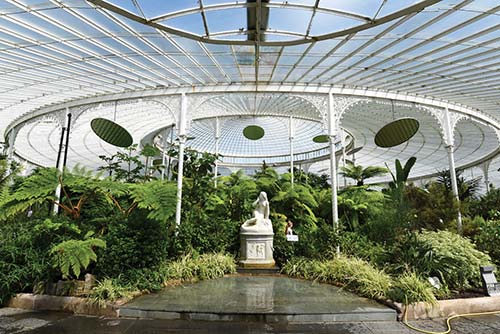
In addition to the finely landscaped gardens, the park has two inviting greenhouse pavilions—both free and open to the public. The big white one on the right (from 1873, open 10:00-18:00) is the most elegant, with classical statues scattered among the palm fronds (but beware the killer plants, to the left as you enter). When the clouds roll in and the weather turns rotten—which is more the status quo—these warm, dry areas become quite popular.
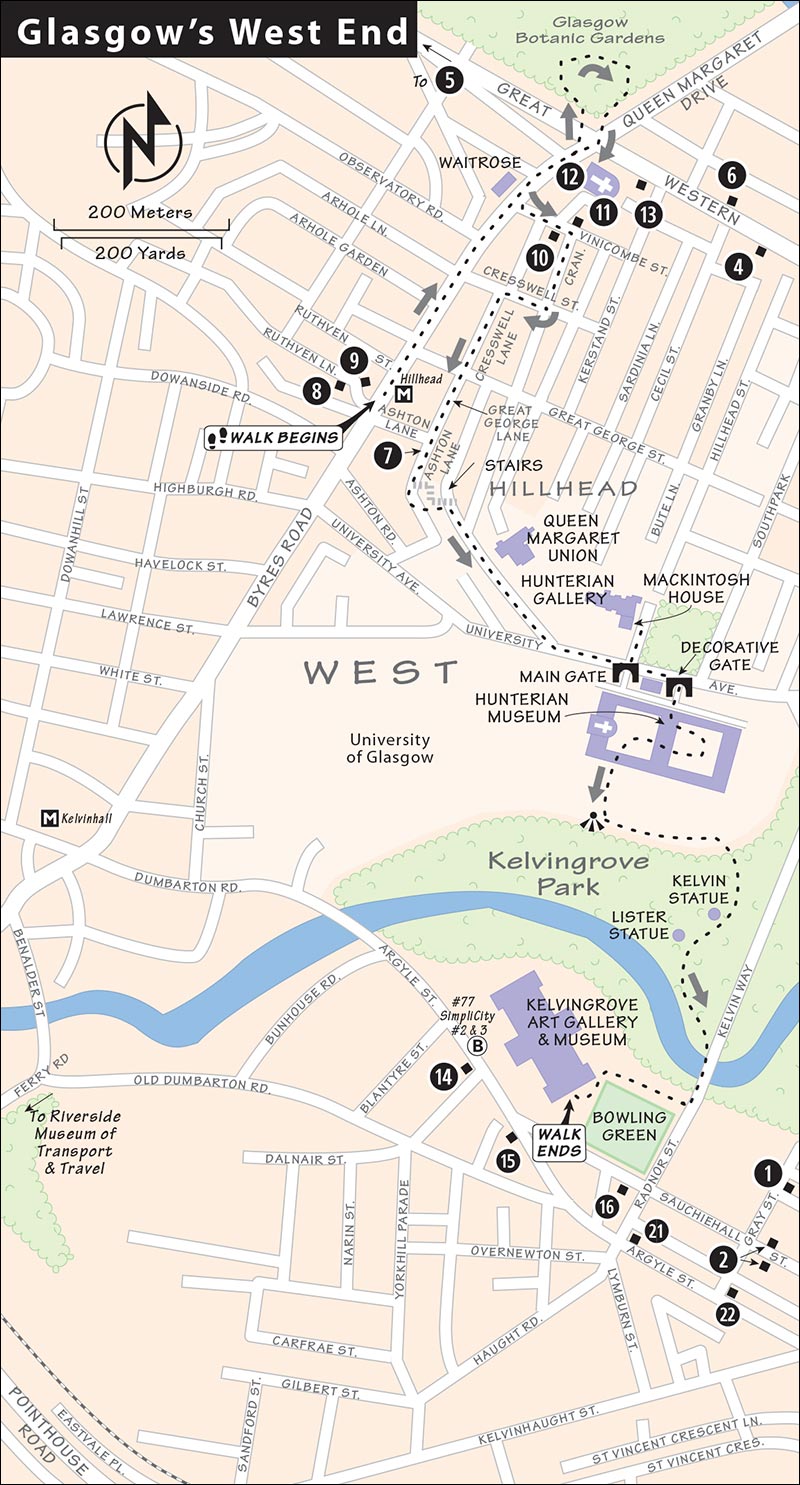
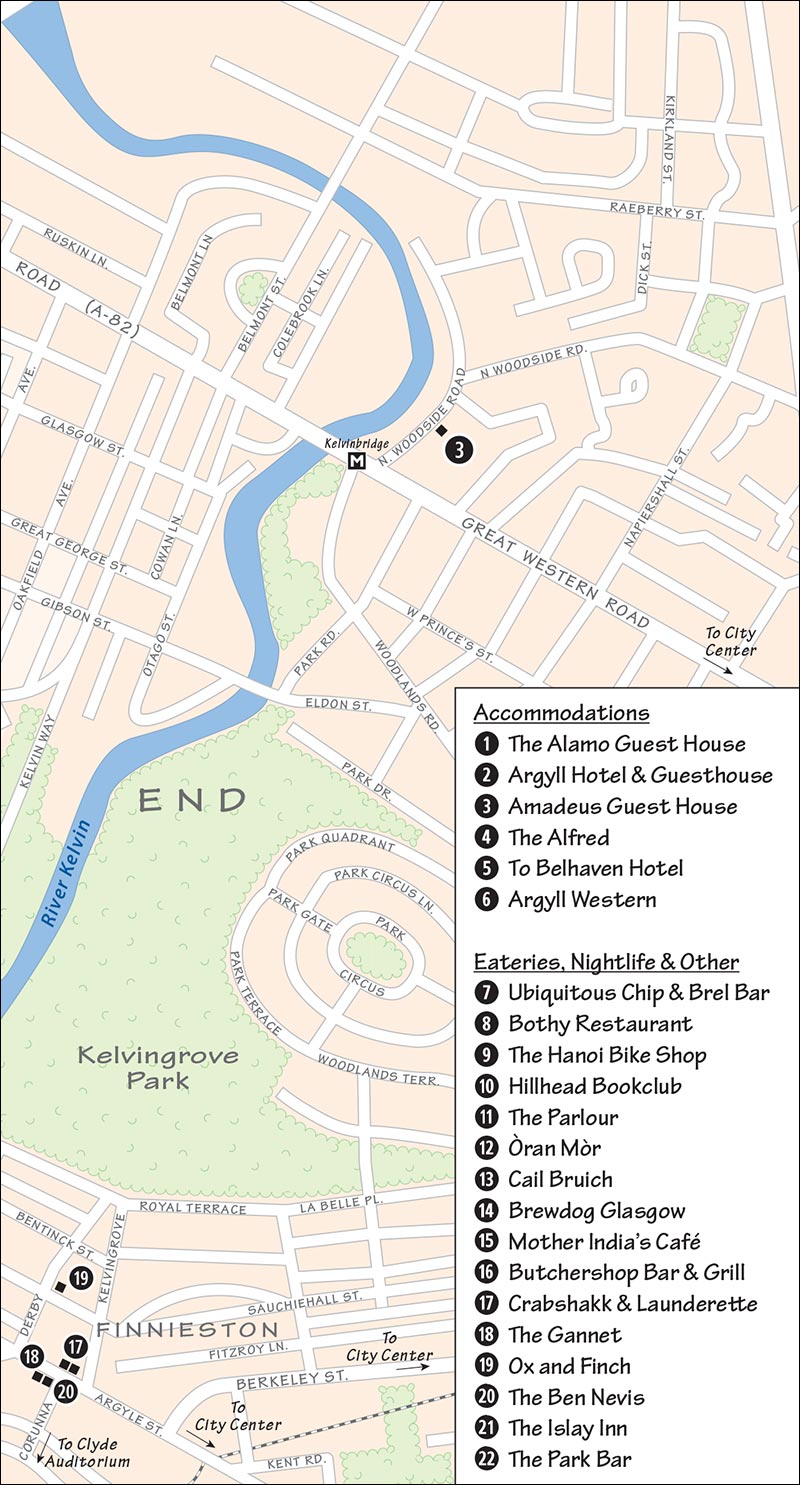

When you’re done in the park, head back out the way you came in. Back on the street, before crossing Great Western Road, go right a few steps to find the blue police call box. Once an icon of British life, these were little neighborhood mini offices where bobbies could store paperwork and equipment, use the telephone, and catch up with each other. These days, some of the call boxes are being repurposed as coffee shops, ice-cream stands, and time machines.
• Cross back over Great Western Road and backtrack (past the Òran Mòr church/restaurant) one block down Byres Road. Turn left down Vinicombe Street (across from the Waitrose). Now we’ll explore...
Back-Streets West End: Peek inside the Hillhead Bookclub—a former cinema that’s been converted into a hipster bar/restaurant serving affordable food (described later, under “Eating in Glasgow”). A half-block after that, turn right and walk (on Crawnworth Street) along the row of red-sandstone tenements. While that word has negative connotations stateside, here a “tenement” is simply an apartment building. And judging from the grand size, bulging bay windows, and prime location of these, it’s safe to say they’re far from undesirable. Many are occupied by a single family, while others are subdivided into five or six rooms for students (the university is right around the corner). Across the street from this tenement row (at #12) is a baths club—a private swimming pool, like an exclusive health club back home. Historically, most people couldn’t afford bathing facilities in their homes, so they came to central locations like this one to get clean every few days (or weeks). Today, it’s the wealthy—not the poor—who come to places like this.
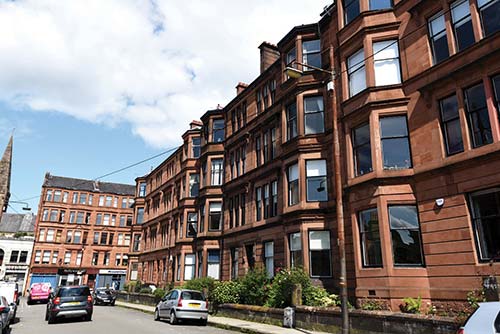
After the baths, turn right down Cresswell Street. A half-block down on the right, turn left down Cresswell Lane—an inviting, traffic-free, brick-floored shopping and dining zone. While the Golden Zed downtown is packed with chain stores, this is where you’ll find charming one-off boutiques.
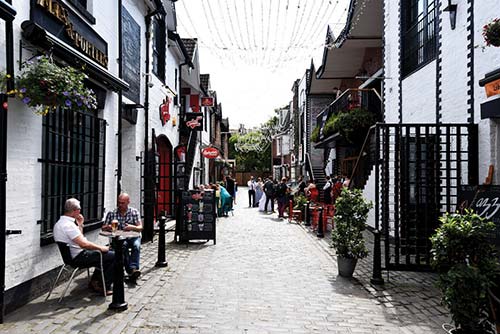
Browse your way to the end of the lane, cross the street, and continue straight to the even more appealing Ashton Lane, strung with fairy lights. Scout this street and pick a place to return for dinner tonight. Fancy a film? Halfway down the street on the right, the Grosvenor Cinema shows both blockbusters and art-house fare (see listing on here).
• When you reach the end of the lane, take a very sharp left up the stairs (with the beer garden for Brel on your left). At the top of the stairs, turn right along the road. You’re now walking through the modern part of the...
University of Glasgow Campus: Founded in 1451, this is Scotland’s second-oldest university (after St. Andrews). Its 24,000 students sprawl through the West End. Unlike the fancy “old university” buildings, this area is gloomy and concrete. The ugly, gray building on your left is the Queen Margaret Union, with a music venue that has hosted several big-name bands before they were famous—from Nirvana to Franz Ferdinand. (If you think Franz Ferdinand is an Austrian archduke rather than a Scottish alternative rock band...you’ve been out of college too long.)
• Eventually you’ll reach a wide cross street, University Avenue. Turn left up this street and walk two more blocks uphill. At the traffic light, the Hunterian Gallery and Mackintosh House are just up the hill on your left, and the Hunterian Museum is across the street on the right.
Hunterian Gallery and Mackintosh House: First, stop in at the Hunterian Gallery to tour the Mackintosh House. In the morning, visits are by tour only; later you can free flow (admission is limited). Ask if there’s a wait, and if so, spend your time either in the adjacent gallery, the wonderful university cafeteria (across the lane, cheap and cheery lunch), or the Hunterian Museum across the street. All three sights (the Mackintosh House, Hunterian Gallery, and Hunterian Museum) are important if you have the time and energy (for details, see here).
• When you’re done here, head for the Hunterian Museum in the university’s big, old, main building across University Avenue. Instead of going through the main gate, go to the left end of the building facing the street to find a more interesting decorative gate.
University of Glasgow Main Building: Take a good look at the gate, which is decorated with the names of illustrious alums. Pick out the great Scots you’re familiar with: James Watt, King James II, Adam Smith, Lord Kelvin, William Hunter (the namesake of the university’s museums), and Donald Dewar, a driving force behind devolution who became Scotland’s first “First Minister” in 1999.
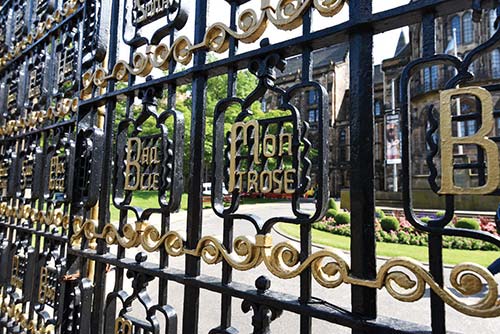
Go through the gate and face the main university building. Stretching to the left is Graduation Hall, where commencement takes place. Head straight into the building, ride the elevator to floor 4, and enjoy the Hunterian Museum.
After you visit the Hunterian Museum, find the grand staircase down (in the room with the Antonine Wall exhibit). You’ll emerge into one of the twin quads enclosed by the enormous ensemble of university buildings. Veer right to find your way into the atmospheric, Neo-Gothic cloisters that support the wing separating the two quads. These are modeled after the Gothic cloisters in the lower chapel of Glasgow Cathedral, across town. On the other side, you’ll pop out into the adjoining quad. Enjoy pretending you’re a student for a few minutes, then head out the door at the bottom of the quad.
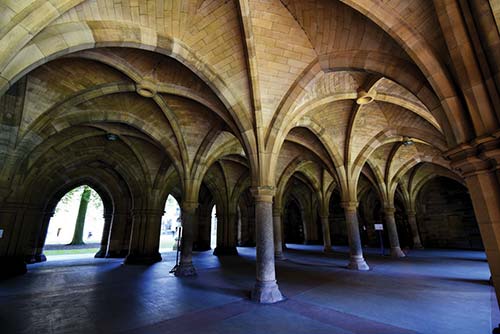
Leaving the university complex, head for the tall flagpole on a bluff overlooking a grand view. The turreted building just below is the Kelvingrove Museum, where this walk ends. (If you get turned around in the park, just head for those spires.)
• From the flagpole, turn left and head to the end of the big building. Head down the stairs leading through the woods on your right (marked James Watt Building). When you reach the busy road, turn right along it for a short distance, then—as soon as you can—angle to the right back into the green space of...
Kelvingrove Park: Another of Glasgow’s favorite parks, this originated in the Victorian period, when there was a renewed focus on trying to get people out into green spaces. One of the first things you’ll come to is a big statue of Lord Kelvin (1824-1907). Born William Thomson, he chose to take the name of the River Kelvin, which runs through Glasgow (and gives its name to many other things here, including the museum we’re headed to). One of the most respected scientists of his time, Kelvin was a pioneer in the field of thermodynamics, and gave his name (or, actually, the river’s) to a new, absolute unit of temperature measurement designed to replace Celsius and Fahrenheit.
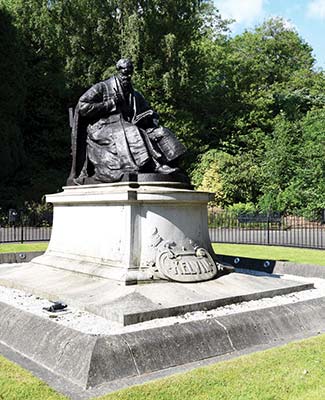
Just past Kelvin, bear left at the statue of Joseph Lister (1827-1912, of “Listerine” fame—he pioneered the use of antiseptics to remove infection-causing germs from the surgical environment), and take the bridge across the River Kelvin. Once across the bridge, turn right toward the museum. You’ll walk along a pleasant bowling green that was built for the Commonwealth Games that Glasgow hosted in 2014. They keep it free and open to anyone—hoping to create a popular interest in this very old and genteel sport (see here for details).
Now’s the time to explore the Kelvingrove Museum, described on here.
• When you’re finished at the museum, exit out the back end, toward the busy road. Several recommended restaurants are ahead and to the left, in the Finnieston neighborhood (see here). Or, if you’d like to hop on the subway, just turn right along Argyle Street and walk five minutes to the Kelvinhall station.
CATHEDRAL PRECINCT, WITH A HINT OF MEDIEVAL GLASGOW
▲St. Mungo Museum of Religious Life and Art
▲Hunterian Gallery and Mackintosh House
▲▲Kelvingrove Art Gallery and Museum
Here’s a chance to drop into a perfectly preserved 1930s-era middle-class residence. The National Trust for Scotland bought this otherwise ordinary row home, located in a residential neighborhood, because of the peculiar tendencies of Miss Agnes Toward (1886-1975). For five decades, she kept her home essentially unchanged. The kitchen calendar is still set for 1935, and canisters of licorice powder (a laxative) still sit on the bathroom shelf. It’s a time-warp experience, where Glaswegian old-timers enjoy coming to reminisce about how they grew up.
Cost and Hours: £6.50, April-Oct daily 13:00-17:00, July-Aug from 11:00, closed Nov-March, guidebook-£3, 145 Buccleuch Street (pronounced “ba-KLOO”), down from the top of Garnethill, tel. 0141/333-0183, www.nts.org.uk.
Visiting the House: Buy your ticket on the main floor, and poke around the little museum. You’ll learn that in Glasgow, a “tenement” isn’t a slum—it’s simply an apartment house. In fact, tenements like these were typical for every class except the richest. Then head upstairs to the apartment, which is staffed by caring volunteers. Ring the doorbell to be let in. Explore the four little rooms. Imagine a world without electricity (Miss Toward was a late adapter, making the leap to electricity only in 1960). Ask about the utility of the iron stove. Ponder the importance of that drawer full of coal and how that stove heated her entire world. Ask why the bed is in the kitchen. As you look through the rooms laced with Victorian trinkets—such as the ceramic dogs on the living room’s fireplace mantle—consider how different they are from Mackintosh’s stark, minimalist designs from the same period.
If you consider bagpipes a tacky Scottish cliché, think again. At this small but insightful museum, you’ll get a scholarly lesson in the proud and fascinating history of the bagpipe. For those with a healthy attention span for history or musical instruments—ideally both—it’s fascinating. On Thursdays, Fridays, and Saturdays at 11:00 and 14:00 a piper is on hand to perform, answer questions, and show you around the collection. At other times, if it’s quiet, ask the ticket-sellers to tell you more—some are bagpipe students at the music school across the street. The center also offers a shop, lessons, a restaurant, and accommodations.
Cost and Hours: £4.50, includes audioguide, Mon-Thu 9:00-19:00, Fri until 17:00, Sat until 15:00, closed Sun, 30 McPhater Street, tel. 0141/353-5551, www.thepipingcentre.co.uk.
Visiting the Museum: The collection is basically one big room packed with well-described exhibits, including several historic bagpipes. You’ll learn that bagpipes from as far away as Italy, Spain, and Bohemia predated Scottish ones; that Lowlands bagpipes were traditionally bellows-blown rather than lung-powered; and why bagpipes started being used to inspire Scottish soldiers on the battlefield. At the back of the room, look for the hand-engraved, backward printing plates for bagpipe sheet music (which didn’t exist until the 19th century). The thoughtful, beautifully produced audioguide—which mixes knowledgeable commentary with sound bites of bagpipes being played and brief interviews with performers—feels like a 40-minute audio-documentary on the BBC. The 15-minute film shown at the end of the room sums up the collection helpfully. They also have a basket of chanters and a practice set of bagpipes in case you want to try your hand. The chanter fingering is easy if you play the recorder, but keeping the bag inflated is exhausting.
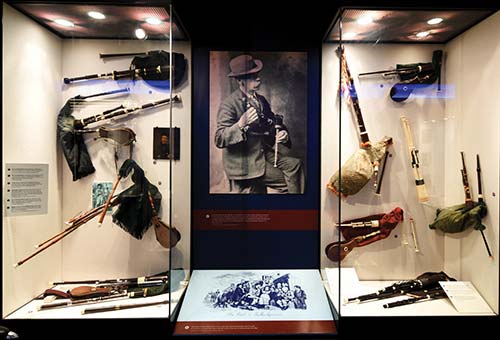
When he was just 28 years old—and still a no-name junior draughtsman for a big architectural firm—Charles Rennie Mackintosh won the contest to create a new home for the Glasgow School of Art. He threw himself into the project, designing every detail of the building, inside and out. Remember that this work was the Art Nouveau original, and that Frank Lloyd Wright, the Art Deco Chrysler Building, and everything that resembles it came well after Charles Rennie Mack’s time.
Unfortunately, the building was badly damaged by a fire in May 2014. It likely won’t open again until 2019 at the earliest. For now, you can join the underwhelming tour of the Reid Building, which includes insight about the architecture of the School of Art and a visit to a small room full of furniture designed by Mackintosh and his wife, Margaret MacDonald. Or you can visit the small, free exhibition about Mackintosh, including an impressive model of the School of Art (shop, exhibition, and tour desk open daily during renovation 10:00-16:30).
Tours: Tours are £7 and last 45 minutes; 6/day in peak season, 4/day in off-season, check times online (tel. 0141/353-4526, www.gsa.ac.uk/tours). Serious admirers can ask about the 2.25-hour Mackintosh-themed city walking tours given by students (£20, 4/week).
Very little remains of medieval Glasgow, but a visit to the cathedral and the area around it is a visit to the birthplace of the city. The first church was built here in the seventh century. Today’s towering cathedral is mostly 13th-century—the only great Scottish church to survive the Reformation intact. In front of the cathedral (near the street), you’ll see an attention-grabbing statue of David Livingstone (1813-1873). Livingstone—the Scottish missionary/explorer/cartographer who discovered a huge waterfall in Africa and named it in honor of his queen, Victoria—was born eight miles from here.
Nearby, the Provand’s Lordship is Glasgow’s only secular building dating from the Middle Ages. The St. Mungo Museum of Religious Life and Art, built on the site of the old Bishop’s Castle, is a unique exhibit covering the spectrum of religions. And the Necropolis, blanketing the hill behind the cathedral, provides an atmospheric walk through a world of stately Victorian tombstones. From there you can scan the city and look down on the brewery where Tennent’s Lager (a longtime Glasgow favorite) has been made since 1885. And, if the spirit moves you, hike on down and tour the brewery (described later).
The following sights are within close range of each other. As you face the cathedral, the St. Mungo Museum is on your right (with handy public WCs), the Provand’s Lordship is across the street from St. Mungo, and the Necropolis is behind the cathedral and to the right. The brewery is a 10-minute walk away.
To reach these sights from Buchanan Street, turn east on Bath Street, which soon becomes Cathedral Street, and walk about 15 minutes (or hop a bus along the main drag—try bus #38, or #57, confirm with driver that the bus stops at the cathedral). To head to the Kelvingrove Museum after your visit, from the cathedral, walk two blocks up Castle Street and catch bus #19 (on the cathedral side).
This blackened, Gothic cathedral is a rare example of an intact pre-Reformation Scottish cathedral. (It was once known as “the Pink Church” for the tone of its stone, but with Industrial Age soot and modern pollution, it blackened. Cleaning would damage the integrity of the stone structure, so it was left black.) The zealous Reformation forces of John Knox ripped out the stained glass and ornate chapels of the Catholic age, but they left the church standing. The church is aching to tell its long and fascinating story and volunteers are standing by to do just that.
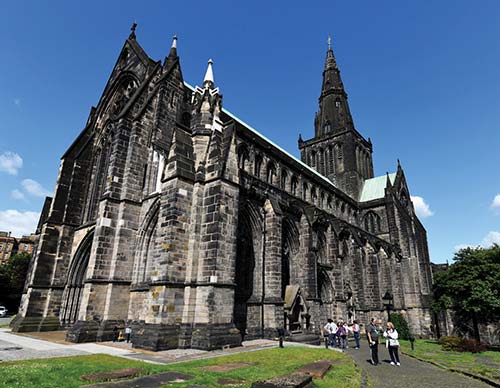
Cost and Hours: Free, £3 suggested donation; Mon-Sat 9:30-17:30, Sun 13:00-17:00; Oct-March until 16:00; request a free tour or join one in progress; near junction of Castle and Cathedral Streets, tel. 0141/552-8198, www.glasgowcathedral.org.uk.
Visiting the Cathedral: Inside, look up to see the wooden barrel-vaulted ceiling, and take in the beautifully decorated section over the choir (“quire”). The choir screen is the only pre-Reformation screen surviving in Scotland. It divided the common people from the priests and big shots of the day, who got to worship closer to the religious action. The cathedral’s glass dates mostly from the 19th century. One window on the right side of the choir, celebrating the 14 trades of Glasgow (try to find them), dates from 1951. Left of that is a set of three windows that tell the story of St. Mungo retrieving a ring from the mouth of a fish (it’s a long story).
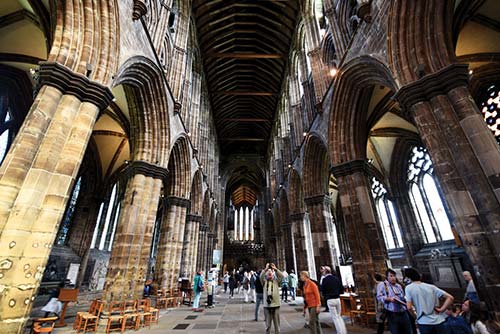
Step into the choir and enjoy the east end with the four evangelists presiding high above in stained glass. Two seats (with high backs, right of altar) are reserved for Queen Elizabeth II and her husband Prince Philip, the Duke of Edinburgh.
Step into the lower church (down stairs on right as you face the choir), where the central altar sits upon St. Mungo’s tomb. Mungo was the seventh-century Scottish monk and mythical founder of Glasgow who established the first wooden church on this spot and gave Glasgow its name. Notice the ceiling bosses (decorative caps where the ribs come together) with their colorfully carved demons, dragons, and skulls.
Nearby: On Cathedral Square, you’ll find the cute Empire Coffee Box, where Rocco is ready to caffeinate you from this old-style police call box.
From the cathedral, a lane leads over the “bridge of sighs” into the park filled with grand tombstones. Glasgow’s huge burial hill has a wistful, ramshackle appeal. A stroll among the tombstones of the eminent Glaswegians of the 19th century gives a glimpse of Victorian Glasgow and a feeling for the confidence and wealth of the second city of the British Empire in its glory days.
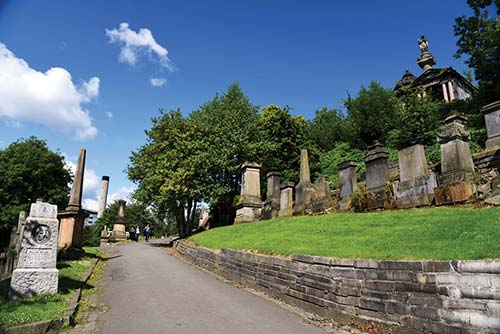
With the Industrial Age (in the early 1800s), Glasgow’s population tripled to 200,000. The existing churchyards were jammed and unhygienic. The city needed a beautiful place in which to bury its beautiful citizens, so this grand necropolis was established. Because Presbyterians are more into simplicity, the statuary is simpler than in a Catholic cemetery. Wandering among the disintegrating memorials to once-important people, I thought about how, someday, everyone’s tombstone will fall over and no one will care.
The highest pillar in the graveyard is a memorial to John Knox. The Great Reformer (who’s actually buried in Edinburgh) looks down at the cathedral he wanted to strip of all art, and even tear down. (The Glaswegians rallied to follow Knox, but saved the church.) If the cemetery’s main black gates are closed, see if you can get in and out through a gate off the street to the right.
This secular, city-run museum, just in front of the cathedral, aims to promote religious understanding. Built in 1990 on the site of the old Bishop’s Castle, it provides a handy summary of major and minor world religions, showing how each faith handles various rites of passage across the human life span: birth, puberty, marriage, death, and everything in between and after. Start with the 10-minute video overview on the first floor, and finish with a great view from the top floor of the cathedral and Necropolis. Ponder the Zen Buddhist garden out back as you leave.
Cost and Hours: Free, £3 suggested donation, Tue-Thu and Sat 10:00-17:00, Fri and Sun from 11:00, closed Mon, free WCs downstairs, cheap ground-floor café, 2 Castle Street, tel. 0141/276-1625, www.glasgowmuseums.com.
Nearby: To view a modern-day depiction of St. Mungo, walk two minutes down High Street from the museum to a building-sized mural by the artist Smug.
With low beams and medieval decor, this creaky home—supposedly the “oldest house in Glasgow”—is the only secular building surviving in Glasgow from the Middle Ages. On three floors it displays the Lifestyles of the Rich and Famous...circa 1471. First, sit down and watch the 10-minute video (ground floor). The interior, while sparse and stony, shows off a few pieces of furniture from the 16th, 17th, and 18th centuries. Out back, explore the St. Nicholas Garden, which was once part of a hospital that dispensed herbal remedies. The plaques in each section show the part of the body each plant is used to treat.
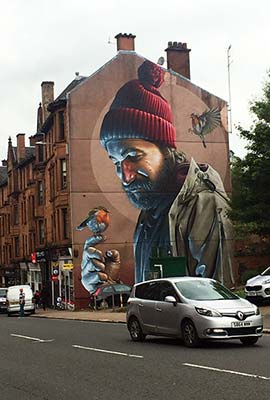
Cost and Hours: Free, small donation requested, Tue-Thu and Sat 10:00-17:00, Fri and Sun from 11:00, closed Mon, across the street from St. Mungo Museum at 3 Castle Street, tel. 0141/552-8819, www.glasgowmuseums.com.
Tennent’s, founded in 1740, is now the biggest brewery in Scotland, spanning 18 acres. They give serious hour-long tours showing how they make “Scotland’s favorite pint,” and how they fill 700 kegs per hour and 1,000 bottles per minute (you’ll see more action Mon-Fri). It’s hot and sweaty inside, with 100 steps to climb on your tour. When you’re done (surrounded by “the Lager Lovelies”—cans from 1965 to 1993 that were decorated with cover girls), you’ll enjoy three samples followed by a pint of your choice (£10, tours depart daily at 10:00, 12:00, 14:00, 16:00, & 18:00; call or book online; 161 Duke Street, 0141/202-7145, www.tennentstours.com). To head back downtown, bus #41 stops in front of the brewery on Duke Street and goes to George Square.
These sights are linked by my West End Walk on here.
Here’s a sightseeing twofer: an art gallery offering a good look at some Scottish artists relatively unknown outside their homeland, and the chance to take a guided tour through the reconstructed home of Charles Rennie Mackintosh, decorated exactly the way he liked it. For Charles Rennie Mack fans—or anyone fascinated by the unique habitats of artists—it’s well worth a visit.
Cost and Hours: Gallery-free, Tue-Sat 10:00-17:00, Sun 11:00-16:00, closed Mon, across University Avenue from the main university building, tel. 0141/330-4221, www.gla.ac.uk/hunterian. Mackintosh House-£5, same hours as gallery, last entry 45 minutes before closing. The Mackintosh House is open weekday mornings by 30-minute tour only (Tue-Fri 10:00-12:30, departs every 30 minutes). After 13:00, and all day Sat-Sun, the house is open without a tour, but only 12 people are allowed at a time, so there may be a short wait.
Visitor Information: First, check in at the reception desk to sign up for a tour of the Mackintosh House or see if there’s a wait to get in. You’ll also need to check any bags (free lockers available). Spend your waiting time visiting the gallery, or, with a longer wait, head across the street to the Hunterian Museum (described later). If it’s lunchtime, eat at $ Food, a cheap, healthy, fast, and modern student cafeteria across the lane from the museum that’s open to the public.
Mackintosh House: In 1906, Mackintosh and his wife, Margaret MacDonald, moved into the end unit of a Victorian row house. Mackintosh gutted the place and redesigned it to his own liking—bathing the interior in his trademark style, a mix of curving, organic lines and rigid, proto-Art Deco functionalism. They moved out in 1914, and the house was demolished in the 1960s—but the university wisely documented the layout and carefully removed and preserved all of Mackintosh’s original furnishings. In 1981, when respect for Mackintosh was on the rise, they built this replica house and reinstalled everything just as Mackintosh had designed it. You’ll see the entryway, dining room, drawing room, and bedroom—each one offering glimpses into the minds of these great artists. You’ll see original furniture and decorations by Mackintosh and MacDonald, providing insight into their creative process.
Hunterian Art Gallery: The adjacent gallery is manageable and worth exploring. Circling one floor, you’ll enjoy three thoughtfully described sections. One highlight is the modern Scottish art (1850-1960), focusing on two groups: the “Glasgow Boys,” who traveled to France to study during the waning days of Realism (1880s), and, a generation later, the Scottish Colourists, who found a completely different inspiration in circa-1910 France—bright, bold, with an almost Picasso-like exuberance. The gallery also has an extensive collection of portraits by American artist James Whistler—Whistler’s wife was of Scottish descent, as was Whistler’s mother. (Hey, that has a nice ring to it.) The painter always found great support in Scotland, and his heir donated his estate to the University of Glasgow.
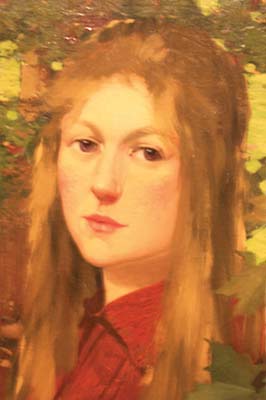
The oldest public museum in Scotland was founded by William Hunter (1718-1783), a medical researcher. Today his natural science collection is housed in a huge and gorgeous space inside the university’s showcase building. Everything is well presented and well explained. You’ll see a perceptive exhibit on the Antonine Wall (the lesser-known cousin of Hadrian’s Wall), built in A.D 142 to seal off the Picts from the Roman Empire. Ancient Roman artifacts on display include leather shoes, plumbing, weapons, and carved reliefs. The eclectic collection also includes musical instruments, a display on the Glasgow-built Lusitania, and a fine collection of fossils, including the aquatic dinosaur called plesiosaur (possibly a distant ancestor of the Loch Ness monster). But to some, most fascinating are the many examples of deformities—two-headed animals, body parts in jars, and so on (main hall, left of Romans). Ever the curious medical researcher, Hunter collected these for study, and these intrigue, titillate, and nauseate visitors to this day.
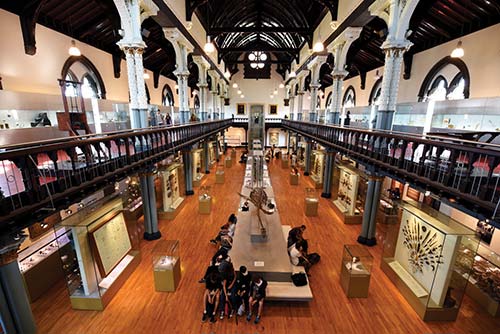
Cost and Hours: Free, Tue-Sat 10:00-17:00, Sun 11:00-16:00, closed Mon, Gilbert Scott Building, University Avenue, tel. 0141/330-4221, www.gla.ac.uk/hunterian.
This “Scottish Smithsonian” displays everything from a stuffed elephant to paintings by the great masters and what, for me, is the city’s best collection of work by Charles Rennie Mackintosh. The well-described contents are impressively displayed in a grand, 100-year-old, Spanish Baroque-style building. The Kelvingrove claims to be one of the most-visited museums in Britain—presumably because of all the field-trip groups you’ll see here. Watching all the excited Scottish kids—their imaginations ablaze—is as much fun as the collection itself.
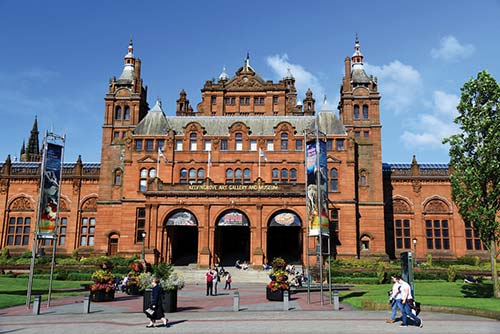
Cost and Hours: Free, £5 suggested donation, Mon-Thu and Sat 10:00-17:00, Fri and Sun from 11:00, free tours at 11:00 and 14:30, Argyle Street, tel. 0141/276-9599, www.glasgowmuseums.com.
Getting There: My self-guided West End Walk leads you here from the Hillhead subway stop, or you can ride the subway to the Kelvinhall stop. When you exit, turn left and walk five minutes. Buses #2 and #3 run from Hope Street downtown to the museum. It’s also on the hop-on, hop-off bus route. No matter how you arrive, just look for the huge, turreted red-brick building.
Organ Concerts: At the top of the main hall, the huge pipe organ booms with a daily 30-minute recital at 13:00 (15:00 on Sunday).
Visiting the Museum: Built in 1901 to house the city collection, the museum is divided into two sections: Art (“Expression”) and Natural (“Life”), each with two floors. The symmetrical floor plan can be confusing. Pick up a map and plan your strategy.
The “Expression” section, in the East Court, is marked by a commotion of heads—each with a different expression—raining down from the ceiling. This half of the museum focuses on artwork, including Dutch, Flemish, French, and Scottish Romanticism from the late 19th century. The exhibits on “Scottish Identity in Art” let you tour the country’s scenic wonders and its history on canvas. The Mackintosh section, a highlight for many, demonstrates the Art Nouveau work of the “Glasgow Four,” including Charles Rennie Mackintosh. Unfortunately, the museum’s star painting, Salvador Dalí’s Christ of St. John of the Cross, will be on the road until 2020.
The “Life” section, in the West Court, features a menagerie of stuffed animals (including a giraffe, kangaroo, ostrich, and moose) with a WWII-era Spitfire fighter plane hovering overhead. Branching off are halls with exhibits ranging from Ancient Egypt to “Scotland’s First People” to weaponry (“Conflict and Consequence”).
For a fun and free activity surrounded by relaxed locals, try your hand at lawn bowling. There’s a mission behind the perfectly manicured greens next to the Kelvingrove Museum (made beautiful to host the 2014 Commonwealth Games): Keep young people interested in the traditional sport. They’ll provide balls (4 per person) and a court time. It’s all free and tourists are welcome. While sunny weekends may be too busy, you’ll always find a court on a cloudy weekday. It’s a fine evening activity; you can bowl rain or shine (April-Sept Mon-Fri 9:00-21:00, Sat-Sun until 18:00, mobile 07920-048-945). Lawn bowling is a lot like petanque (popular in France); the object and scoring are the same. The balls are bigger and “biased” (lopsided on purpose to let experts throw curves). Let the attendant explain the rules if necessary. (They also rent tennis gear for the adjacent courts.) An efficient plan would be to end your sightseeing day at the huge Kelvingrove Museum (closes at 17:00), play an hour of “bowls,” and have dinner a couple blocks away at a recommended Finnieston restaurant of your choice. You could cap your night with a beer and live music at a Gaelic pub.
Located along the River Clyde, this high-tech, extremely kid-friendly museum—nostalgic and modern at the same time—is dedicated to all things transportation-related. Named the European museum of the year in 2013, visiting is a must for anyone interested in transportation and how it has shaped society.
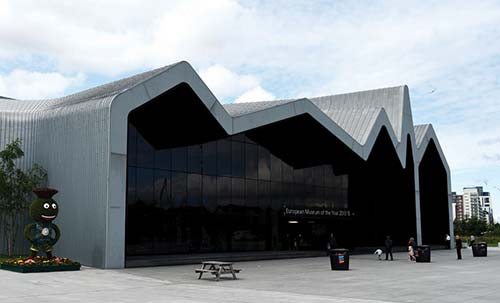
Cost and Hours: Free, £5 suggested donation, Mon-Thu and Sat 10:00-17:00, Fri and Sun from 11:00, ground-floor café with £6-9 meals, upstairs coffee shop with basic drinks and snacks, 100 Pointhouse Place, tel. 0141/287-2720, www.glasgowmuseums.com.
Getting There: It’s on the riverfront promenade, two miles west of the city center. Bus #100 runs between the museum and George Square (2/hour, last departure from George Square at 15:02, operated by McColl’s), or you can take a taxi (£6-8, 10-minute ride from downtown). The museum is also included on the hop-on, hop-off sightseeing bus route (described on here, under “Tours in Glasgow”).
Visiting the Museum: Most of the collection is strewn across one huge, wide-open floor. Upon entering, visit the info desk (to the right as you enter, near the shop) to ask about today’s free tours and activities—or just listen for announcements. Also pick up a map from the info desk, as the museum’s open floor plan can feel a bit like a traffic jam at rush hour.
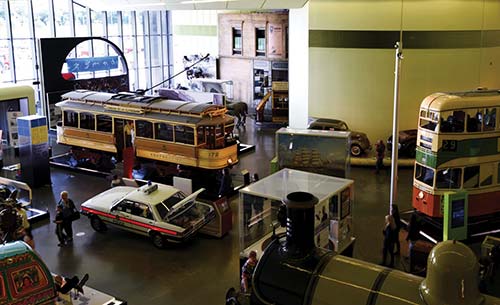
Diving in, explore the vast collection: stagecoaches, locomotives, double-decker trolleys, and an entire wall stacked with vintage automobiles and another with motorcycles. Learn about the opening of Glasgow’s old-timey subway (Europe’s third oldest). Explore the collections of old toys and prams, and watch a film about 1930s cinema. Stroll the re-creation of a circa-1900 main street, with video clips bringing each shop to life (there’s one about a little girl who discovers her daddy was selling things to the pawn shop to pay the rent).
Don’t miss the much-smaller upstairs section, with great views over the River Clyde (cross the footbridge over the trains), additional exhibits about ships built here in Glasgow, and what may be the world’s oldest bicycle. The description explains how two different inventors have tried to take credit for the bike—and both of them are Scottish.
Nearby: Be sure to head to the River Clyde directly behind the museum (just step out the back door). The Glenlee, one of five remaining tall ships built in Glasgow in the 19th century (1896), invites visitors to come aboard (free, daily 10:00-17:00, Nov-Feb until 16:00, tel. 0141/357-3699, www.thetallship.com). Good exhibits illustrate what it was like to live and work aboard the ship. Explore the officers’ living quarters, then head below deck to the café and more exhibits. Below that, the cargo hold has kids’ activities and offers the chance to peek into the engine room. As you board, note the speedboat river tour that leaves from here each afternoon (£10, 20 minutes).
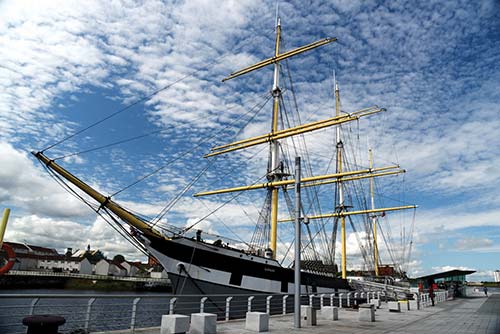
This eclectic art collection of a wealthy local shipping magnate—which includes sculpture from Roman to Rodin, stained glass, tapestries, furniture, Asian and Islamic works, and halls of paintings starring Cézanne, Renoir, Degas, and a Rembrandt self-portrait—is closed for renovation until at least 2020 (three miles outside the city center in Pollok Country Park, tel. 0141/287-2550, www.glasgowmuseums.com).
Downtown, the Golden Zed—a.k.a. “Style Mile”—has all the predictable chain stores, with a few Scottish souvenir stands mixed in. For more on this, see the start of my self-guided “Get to Know Glasgow” walk. The Glasgow Modern Art Museum (GoMA) has a quirky gift shop that many find enticing.
The West End also has some appealing shops. Many are concentrated on Cresswell Lane (covered in my self-guided West End Walk). Browsing here, you’ll find an eclectic assortment of gifty shops, art galleries, design shops, hair salons, record stores, home-decor shops, and lots of vintage bric-a-brac. Be sure to poke into De Courcy’s Arcade, a two-part warren of tiny offbeat shops.
Glasgow has a youthful vibe, and its nightlife scene is renowned. The city is full of live music acts and venues. Walking through the city center, you’ll pass at least one club or bar on every block.
Downtown: Glasgow’s central business and shopping district is pretty sleepy after hours, but there are a few pockets of activity—each with its own personality. Bath Street’s bars and clubs are focused on young professionals as well as students; the recommended Pot Still is a perfect place to sample Scotch whisky (see “Eating in Glasgow,” later). Nearby, running just below the Glasgow School of Art, Sauchiehall Street is younger, artsier, and more student-oriented. The recently revitalized Merchant City zone, stretching just east of the Buchanan Street shopping drag, has a slightly older crowd and a popular gay scene.
West End: You’ll find fun bars and music venues in Hillhead, on Ashton Lane and surrounding streets. Finnieston, just below the Kelvingrove Museum, is packed with trendy bars and restaurants. But it also has an old-school selection of spit-and-sawdust Gaelic pubs, some of which have live music in the evenings (see next).
Glasgow has a great music scene, on its streets (talented buskers) and in its bars and clubs (including trad sessions). For the latest, The Skinny is Glasgow’s information-packed alternative weekly (www.theskinny.co.uk). Or check out The List (www.list.co.uk) or the Gig Guide (www.gigguide.co.uk). All three are also available in print around town. Or check out what’s going on at these bars:
The following pubs line up along Argyle Street.
The Ben Nevis hosts lively, toe-tapping sessions three times a week. It’s a good scene—full of energy but crowded. Show up early to grab a seat in this tiny pub, or be ready to stand (Wed, Thu, and Sun at 21:00, no food service—just snacks, #1147).
The Islay Inn has bands twice weekly—some traditional, some doing contemporary covers. On nonmusic nights you’ll find televisions blasting sports (music Fri and Sat at 21:00, food available, #1256, at corner with Radnor).
At The Park Bar, you’ll find live music several nights a week, including traditional Scottish bands and sessions on Thursdays (Thu-Sun around 21:00, food available, #1202).
The Òran Mòr (a former church, www.oran-mor.co.uk) and Hillhead Bookclub (a former cinema, www.hillheadbookclub.co.uk) are popular live music venues (both recommended later, under “Eating in Glasgow”).
Jinty McGuinty’s has acoustic music every night, ranging from chart hits to Irish classics to soul and blues (daily at 21:30, 29 Ashton Lane).
Twice weekly at Babbity Bowster, musicians take over a corner of this cute pub (under a recommended B&B) for a trad session. The music, energy, and atmosphere are top-notch (Wed and Sat at 15:00, solid pub grub, 16 Blackfriars Street).
Sloans, hidden away through a muraled tunnel off Argyle Street, is a fun pub with outdoor tables filling an alley. They have live traditional music on Wednesdays (21:00) and ceilidh dancing instruction on Fridays (£10, starts at 20:30, book ahead, food available, 108 Argyle Street, www.sloansglasgow.com).
Waxy O’Connor’s is a massive, multilevel Irish bar featuring a maze of dark, atmospheric rooms, a tree climbing up a wall, and lots of live music (usually acoustic—check their website for days/times) and trad sessions on Sundays at 15:00 (food available, 44 West George Street, www.waxyoconnors.co.uk).
The Grosvenor Cinema, right on Ashton Lane in the heart of the bustling West End restaurant scene, is an inviting movie theater, with cushy leather seats in two theaters showing films big and small (most movies £10) and lots of special events. Wine and beer are available at the theater, or you can order cocktails and warm food at the bar next door and have it delivered to your seat (21 Ashton Lane, tel. 0845-166-6002, www.grosvenorcinema.co.uk).
For accommodations, choose between downtown (bustling by day, nearly deserted at night, close to main shopping zone and some major sights, very expensive parking and one-way streets that cause headaches for drivers) and the West End (neighborhoody, best variety of restaurants, easier parking, easy access to West End sights and parks but a bus or subway ride from the center and train station).
These accommodations are scattered around the city center. For locations, see the map on here. Glasgow also has all the predictable chains—Ibis, Premier Inn, Travelodge, Novotel, Mercure, Jurys Inn, EasyHotel—check online for deals.
$$$ Pipers’ Tryst has eight simple rooms enthusiastically done up in good tartan style above a restaurant in the National Piping Centre (described on here). It’s in a grand, old former church building overlooking a busy intersection, across the street from the downtown business, shopping, and entertainment district. The location is handy, if not romantic, and it’s practically a pilgrimage for fans of bagpipes (30 McPhater Street, tel. 0141/353-5551, www.thepipingcentre.co.uk, hotel@thepipingcentre.co.uk).
$$$ Z Hotel, part of a small “compact luxury” chain, offers 104 sleek, stylish rooms (some are very small and don’t have windows). It’s welcoming and handy to Queen Street Station, just a few steps off George Square (breakfast extra, air-con, elevator, free wine-and-cheese buffet each afternoon, 36 North Frederick Street, tel. 0141/212-4550, www.thezhotels.com, glasgow@thezhotels.com).
$$ Grasshoppers is a cheerful, above-it-all retreat on the sixth floor of a building overlooking Central Station. The street-level entry is minimal, but popping out of the elevator, you know you’ve arrived. The 29 rooms are tight, with small “efficiency” bathrooms, but the welcome is warm and there’s 24-hour access to fresh cupcakes, shortbread, and ice cream (free breakfast to those booking direct, optional buffet dinner, elevator, 87 Union Street, tel. 0141/222-2666, www.grasshoppersglasgow.com, info@grasshoppersglasgow.com).
$$ Motel One, part of a stylish German budget hotel chain, has 374 rooms and is conveniently located right next to Central Station (corner of Oswald and Argyle streets, www.motel-one.com).
$ Babbity Bowster, named for a traditional Scottish dance, is a pub and restaurant renting five simple, mod rooms up top. It’s located in the trendy Merchant City area on the eastern fringe of downtown, near several clubs and restaurants (no breakfast, lots of stairs and no elevator, 10-minute walk from either station, 16 Blackfriars Street, tel. 0141/552-5055, www.babbitybowster.com, info@babbitybowster.com). The ground-floor $$ pub serves good grub (daily 12:00-22:00) and has twice-weekly sessions (see “Nightlife and Entertainment in Glasgow”).
¢ The huge Euro Hostel (over 400 beds) is a well-run and well-located option for those on a tight budget (private rooms, family rooms, all rooms have en-suite bathrooms, breakfast extra, kitchen, bar, very central on the River Clyde near Central Station, 318 Clyde Street, tel. 0845-539-9956, www.eurohostels.co.uk, glasgow@eurohostels.co.uk).
For a more appealing neighborhood experience, bunk in the West End—the upper-middle-class neighborhood just a few subway stops (or a 15-minute, £8 taxi ride) from downtown. As this is also one of the city’s best dining zones, you’ll likely come here for dinner anyway—so why not sleep here? My favorites in this area are the Alamo and Amadeus, which have the most personality. For locations, see the map on here.
These places are in an inviting residential area near the Kelvingrove Museum (not as handy to the subway, but easy by bus). They’re close to the lively Argyle Street scene, with good restaurants and fun Gaelic pubs.
$$ The Alamo Guest House, energetically run by Steve and Emma, faces the bowling green and tennis court. It has rich, lavishly decorated public spaces and 10 comfortable rooms, including two luxury suites with bathtubs (family room, some rooms with bathroom down the hall, 2- or 3-night minimum stay on weekends in peak season, 46 Gray Street, tel. 0141/339-2395, www.alamoguesthouse.com, info@alamoguesthouse.com).
At the $$ Argyll Hotel and Guesthouse you won’t forget you’re in Scotland. Each room is accessorized with a different tartan and has info on the associated clan, while the halls are adorned with symbols of Scotland (bagpipes, thistle, local landmarks, etc.). The hotel has an elevator, breakfast room, and higher prices than the guesthouse (guesthouse customers must cross the street for breakfast and deal with stairs). Otherwise the rooms are just as nice and a bit larger in the guesthouse (family rooms, save money by skipping breakfast, 973 Sauchiehall Street, tel. 0141/337-3313, www.argyllhotelglasgow.co.uk, info@argyllhotelglasgow.co.uk).
$$ Amadeus Guest House, a classy refuge just north of the large Kelvingrove Park, has nine modern rooms and artistic flourishes. It hides down a quiet street yet is conveniently located near the Kelvinbridge subway stop—just a 10-minute walk or one subway stop from the restaurant zone (includes continental breakfast, 411 North Woodside Road, tel. 0141/339-8257, www.amadeusguesthouse.co.uk, reservations@amadeusguesthouse.co.uk, Alexandra).
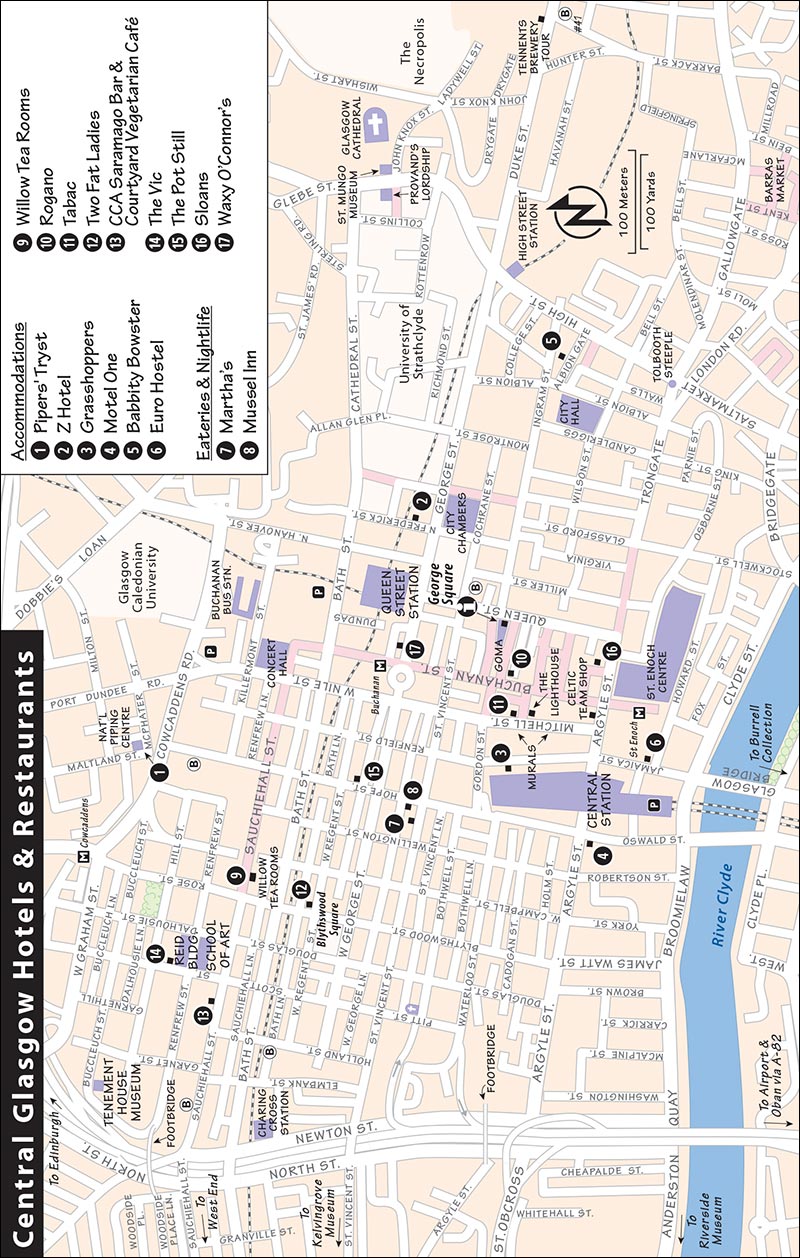
These places, overlooking the busy Great Western Road, are close to the Botanic Gardens and Hillhead restaurant scene but farther from the center (10-minute walk to Hillhead subway stop or catch bus to center from Great Western Road).
$$ The Alfred, run by the landmark Òran Mòr restaurant/pub (located in the former church just up the street), brings a contemporary elegance to the neighborhood, with 14 new-feeling, stylish rooms (family room, includes continental breakfast, 1 Alfred Terrace, tel. 0141/357-3445, www.thealfredhotelglasgow.co.uk, alfred@thealfredhotelglasgow.co.uk).
$$ Belhaven Hotel, a little farther out (about 10 minutes past Byres Road), has 18 rooms in an elegant four-floor townhouse with a pretty, tiled atrium (save money by skipping breakfast, bar in breakfast room serves drinks to guests, no elevator, 15 Belhaven Terrace, tel. 0141/339-3222, www.belhavenhotel.com, info@belhavenhotel.com).
$ Argyll Western, with 17 sleek and tartaned Scottish-themed rooms, feels modern, efficient, and a bit impersonal (breakfast extra, 6 Buckingham Terrace, tel. 0141/339-2339, www.argyllwestern.co.uk, info@argyllwestern.co.uk, same family runs the Argyll Hotel, listed earlier).
(See “Central Glasgow Hotels & Restaurants” map, here.)
$ Martha’s is ideal for hungry, hurried sightseers (and local office workers) in search of a healthy and satisfying lunch. They serve a seasonal menu of wraps, rice boxes, soups, and other great meals made with Scottish ingredients but with eclectic, exotic, international flavors (Indian, Thai, Mexican, and so on). It’s understandably popular: Just line up (it moves fast), order at the counter, and then find a table or take your food to go (Mon-Fri 7:30-18:00, closed Sat-Sun, 142A St. Vincent Street, tel. 0141/248-9771).
$$$ Mussel Inn offers light, good-value fish dinners and seafood plates in an airy, informal environment. The restaurant is a cooperative, owned and run by shellfish farmers. Their “kilo pot” of Scottish mussels is popular with locals and big enough to share (“lunchtime quickie” deals, daily specials, daily 12:00-14:30 & 17:00-22:00, 157 Hope Street, tel. 0141/572-1405).
$$ The Willow Tea Rooms, designed by Charles Rennie Mackintosh, has a diner-type eatery and a classy Room de Luxe. The cheap and cheery menu covers both dining areas (afternoon tea, Mon-Sat 9:00-17:00, Sun from 10:30, reservations smart, 217 Sauchiehall Street, tel. 0141/332-0521, www.willowtearooms.co.uk).
Rogano is a time-warp Glasgow institution that retains much of the same classy Art Deco interior it had when it opened in 1935. The restaurant has three distinct sections: $$ The Rogano Bar in front is an Art Deco diner with dressy outdoor seating and serves soups, sandwiches, and simple dishes; $$$$ The Rogano Restaurant, a fancy dining room at the back of the main floor that smacks of the officers’ mess on the Queen Mary, focuses on seafood, classic Scottish dishes, and afternoon tea (their early menu—until 19:00—is a good deal); $$$ The Rogano Café, a more casual yet still dressy bistro in the cellar, is filled with 1930s-Hollywood posters and offers a similar menu to the fancy restaurant, but cheaper (daily 12:00-16:00 & 18:00-21:30, 11 Exchange Place—just before giant Merchant City archway just off Buchanan Street, reservations smart, tel. 0141/248-4055, www.roganoglasgow.com).
$$ Tabac is a dark, mod, and artsy cocktail bar with spacious seating on a narrow lane just off Buchanan Street. They serve pizza, burgers, and big salads (daily 12:00-24:00, food served until 21:00, across from “The Lighthouse” at 10 Mitchell Lane, tel. 0141/572-1448).
$$$ Two Fat Ladies is a hardworking and dressy little place with a focus on food rather than atmosphere and a passion for white fish (early-bird menu until 18:15 a great value, daily 12:00-14:30 & 17:00-22:00, 118 Blythswood Street, tel. 0141/847-0088).
$$ CCA Saramago Bar and Courtyard Vegetarian Café, located on the first floor of Glasgow’s edgy contemporary art museum, charges art-student prices for its designer, animal-free food. An 18th-century facade, discovered when the site was excavated to build the gallery, looms over the atrium restaurant (food served daily 12:00-22:00, free Wi-Fi, 350 Sauchiehall Street, tel. 0141/332-7959).
$ The Vic is a student hangout within the Glasgow School of Art itself. Face the modern Reid Building and hook around the left side to find the easy-to-miss entrance to this funky bar/café with starving-artist fare from an eclectic, international menu (Mon-Sat 12:00-21:00, closed Sun).
For Your Whisky: The Pot Still is an award-winning malt whisky bar dating from 1835 that’s also proud of its meat pies. You’ll see locals of all ages sitting in its leathery interior, watching football (soccer), and discussing their drinks. Give the friendly bartenders a little background on your beverage tastes, and they’ll narrow down a good choice for you from their long list (daily 11:00-24:00, 154 Hope Street, tel. 0141/333-0980, Frank has the long beard).
(See “Glasgow West End” map, here.)
This hip, lively residential neighborhood/university district is worth exploring, particularly in the evening. The restaurant scene focuses on two areas (at opposite ends of my West End Walk): near the Hillhead subway stop and, farther down, in the Finnieston neighborhood near the Kelvingrove Museum. For locations, see the map on here. It’s smart to book ahead at any of these places for weekend evenings.
(See “Glasgow West End” map, here.)
There’s a fun concentration of restaurants on the streets that fan out from the Hillhead subway stop (£8 taxi ride from downtown). If it’s a balmy evening, several have convivial gardens designed to catch the evening sun. Before choosing a place, take a stroll and scout the Ashton Lane scene, which has the greatest variety of places (including Ubiquitous Chip and Brel Bar, recommended next). Tucked away on Ruthven Lane (opposite the subway station) are Bothy Restaurant and The Hanoi Bike Shop. And a couple blocks away (near the Botanic Gardens) are Hillhead Bookclub, The Parlour, Òran Mòr, and Cail Bruich.
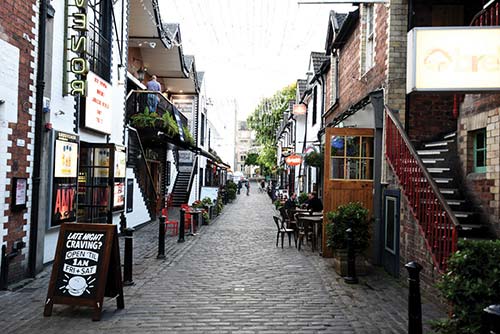
$$$$ Ubiquitous Chip, aka “The Chip,” is a beloved local landmark with a couple inviting pubs and two great restaurant options. On the ground floor is their fine restaurant with beautifully presented contemporary Scottish dishes in a garden atrium. Their early-bird menu (order by 18:30) is a great value. Upstairs (looking down on the scene) is the less-formal, less-expensive, but still very nice brasserie (daily 11:00-22:00, 12 Ashton Lane, tel. 0141/334-5007, www.ubiquitouschip.co.uk).
$$ Brel Bar is a fun-loving place with a happy garden and a menu with burgers, mussels, and quality bar food. On a nice evening, its backyard beer garden is hard to beat (daily 12:00-24:00, 37 Ashton Lane, tel. 0141/342-4966).
$$$ Bothy Restaurant is a romantic place offering tasty, traditional Scottish fare served by waiters in kilts. Sit outside in the inviting alleyway or in the rustic-contemporary dining room (daily 12:00-22:00, down the lane opposite the subway station to 11 Ruthven Lane, tel. 0141/334-4040).
$$ The Hanoi Bike Shop, a rare-in-Scotland Vietnamese “street food” restaurant, serves Asian tapas that are healthy and tasty, using local produce. With tight seating and friendly service, the place has a fun energy (daily 12:00-23:00, 8 Ruthven Lane, tel. 0141/334-7165).
$$ Hillhead Bookclub is a historic cinema building cleared out to make room for fun, disco, pub grub, and lots of booze. It’s a youthful and quirky art-school scene, with lots of beers on tap, creative cocktails, retro computer games, ping-pong, and theme evenings like “drag queen bingo” night. The menu: meat pies, fish-and-chips, burgers, and salads (daily 10:00-21:30, 17 Vinicombe Street, tel. 0141/576-1700).
$$ The Parlour, across from the Hillhead Bookclub, gets all the evening sun on its terrace seating. In bad weather, the spacious interior is warmed by an open fire. It’s young, fun, and pub-like, with pizza, tacos, burgers, and creative cocktails (daily 11:00-21:30, 28 Vinicombe Street, mobile 07943-852-973).
$$ Òran Mòr fills a converted church from the 1860s with a classic pub. They offer basic pub grub either inside or on the front-porch beer garden (daily 10:00-21:00, later on weekends, across from the Botanic Gardens at 731 Great Western Road, tel. 0141/357-600).
$$$$ Cail Bruich serves award-winning classic Scottish dishes with an updated spin in an elegant and romantic setting. Reservations are smart (classy tasting menus for £35-45, lunch Wed-Sun 12:00-14:00, dinner Mon-Sat 18:00-21:00, 725 Great Western Road, tel. 0141/334-6265, www.cailbruich.co.uk).
(See “Glasgow West End” map, here.)
These three places are immediately across from the Kelvingrove Museum (which is likely to leave you hungry). They’re more basic and less trendy than the Finnieston places (a few blocks away, listed next) that will leave you with better memories.
$$ Brewdog Glasgow is a beer-and-burgers joint. It’s a great place to sample Scottish microbrews—from their own brewery in Aberdeen, as well as guest brews—in an industrial-mod setting reminiscent of American brewpubs (daily 12:00-24:00, 1397 Argyle Street, tel. 0141/334-7175, www.brewdog.com).
$$ Mother India’s Café serves basic Indian and is a good stop if you crave Scotland’s national dish: “a good curry.” The menu features small plates designed to enjoy family-style (about two plates per person makes a meal, daily 12:00-22:30, 1355 Argyle Street, tel. 0141/339-9145).
$$$ Butchershop Bar & Grill is a casual, rustic, American-style steakhouse, but featuring Scottish products—focusing on dry-aged Scottish steaks (lunch and early-bird deals, daily 12:00-22:00, 1055 Sauchiehall Street, tel. 0141/339-2999, www.butchershopglasgow.com).
(See “Glasgow West End” map, here.)
This trendy, up-and-coming neighborhood—with a hipster charm in this hipster city—stretches east from in front of the Kelvingrove Museum (a 10-minute walk from the Kelvinhall or Kelvinbridge subway stops). Each of these is likely to require a reservation. The Crabshakk started things off here and today it anchors a strip of similarly funky, foodie eateries.
$$ Crabshakk, specializing in fresh, beautifully presented seafood, is a foodie favorite, with a very tight bar-and-mezzanine seating area and tables spilling out onto the sidewalk. It’s casual but still respectable, and worth reserving ahead (daily 12:00-22:00, 1114 Argyle Street, tel. 0141/334-6127, www.crabshakk.com).
$$$ The Gannet emphasizes Scottish ingredients with a modern spin. It’s relaxed and stylish but the owners/chefs are serious about the food (lunch Thu-Sat 12:00-14:00, dinner Tue-Sat 17:00-21:30, Sun 13:00-19:30, closed Mon, 1155 Argyle Street, tel. 0141/204-2081, www.thegannetgla.com).
$$ Ox and Finch, with a romantic setting, open kitchen, and smart clientele, serves modern international cuisine. It features small plates in an upscale, rustic, wood-meets-industrial atmosphere (daily 12:00-22:00, 920 Sauchiehall Street, tel. 0141/339-8627, www.oxandfinch.com).
Traveline Scotland has a journey planner that’s linked to all of Scotland’s train and bus schedule info. Go online (www.travelinescotland.com), call them at tel. 0871-200-2233, or use the individual websites listed below. If you’re connecting with Edinburgh, note that the train is faster but the bus is cheaper.
From Glasgow’s Queen Street Station by Train to: Oban (5/day, 3 hours), Fort William (3/day, 4 hours), Inverness (5/day direct, 3 hours, more with change in Perth), Edinburgh (6/hour, 50 minutes), Stirling (3/hour, 45 minutes), Pitlochry (4/day direct, 1.5 hours, more with change in Perth).
From Glasgow’s Central Station by Train to: Keswick in England’s Lake District (hourly, 1.5 hours to Penrith, then catch a bus to Keswick, 45 minutes), Cairnryan for ferry to Belfast (take train to Ayr, 2/hour, 1 hour; then ride bus to Cairnryan, 1 hour), Liverpool (2/hour, 4 hours, change in Wigan or Preston), Durham (2/hour, 3 hours, may require change in Edinburgh), York (hourly, 4 hours, more with change in Edinburgh), London (2/hour, 5 hours direct). Train info: Tel. 0345-748-4950, www.nationalrail.co.uk.
Glasgow’s Buchanan bus station is a hub for reaching the Highlands. If you’re coming from Edinburgh, you can take the bus to Glasgow and transfer here. Or, for a speedier connection, zip to Glasgow on the train, then walk a few short blocks to the bus station. (Ideally, try to arrive at Glasgow’s Queen Street Station, which is closer to the bus station.) For more details on these connections, see “Getting Around the Highlands” on here.
From Glasgow by Bus to: Edinburgh (Citylink bus #900, 4/hour, 1.5 hours), Oban (Citylink buses #976 and #977; 5/day, 3 hours), Fort William (Citylink buses #914, #915, and #916; 8/day, 3 hours), Glencoe (Citylink buses #914, #915, and #916; 8/day, 2.5 hours), Inverness (5/day on Citylink express bus #G10, 3 hours; 1/day direct on National Express #588, 4 hours), Portree on the Isle of Skye (Citylink buses #915 and #916, 3/day, 7 hours), Pitlochry (1/day direct on National Express #588, 5/day on Megabus to Perth, then transfer to Citylink bus for Pitlochry, 2.5 hours—train is faster), Stirling (hourly on Citylink #M8, 45 minutes). Citylink: tel. 0871-266-3333, www.citylink.co.uk. National Express: tel. 0871-781-8181, www.nationalexpress.com.
Glasgow International Airport: Located eight miles west of the city, this airport (code: GLA) has currency-exchange desks, a TI, luggage storage, and ATMs (tel. 0844-481-5555, www.glasgowairport.com). Taxis connect downtown to the airport for about £25. Your hotel can likely arrange a private taxi service for £15, or you can take Uber.
Bus #500 zips to central Glasgow (every 10 minutes, 5:00-23:00, £7.50 one-way, £10 round-trip, 25 minutes to both train stations and the bus station, catch at bus stop #1). Slow bus #77 goes to the West End, stopping at the Kelvingrove Museum and rolling along Argyle Street (departs every 30 minutes, £5 one-way, 50 minutes).
Prestwick Airport: A hub for Ryanair, this airport is 30 miles southwest of the city center (code: PIK, tel. 0871-223-0700, ext. 1006, www.glasgowprestwick.com). The best connection is by train, which runs between the airport and Central Station (3/hour, 50 minutes, half-price with Ryanair ticket, trains also run to Edinburgh Waverley Station—about 2/hour, 2 hours). Stagecoach buses link the airport with Buchanan Bus Station (£10, 1-2/hour, 50 minutes, www.stagecoachbus.com).
From England’s Lake District to Glasgow: From Keswick, take the A-66 for 18 miles to the M-6 and speed north nonstop (via Penrith and Carlisle), crossing Hadrian’s Wall into Scotland. The road becomes the M-74 just north of Carlisle. To slip through Glasgow quickly, leave the M-74 at Junction 4 onto the M-73, following signs to M-8/Glasgow. Leave the M-73 at Junction 2, exiting onto the M-8. Stay on the M-8 west through Glasgow, exit at Junction 30, cross Erskine Bridge, and turn left on the A-82, following signs to Crianlarich and Loch Lomond. (For a scenic drive through Glasgow, take exit 17 off the M-8 and stay on the A-82 toward Dumbarton.)